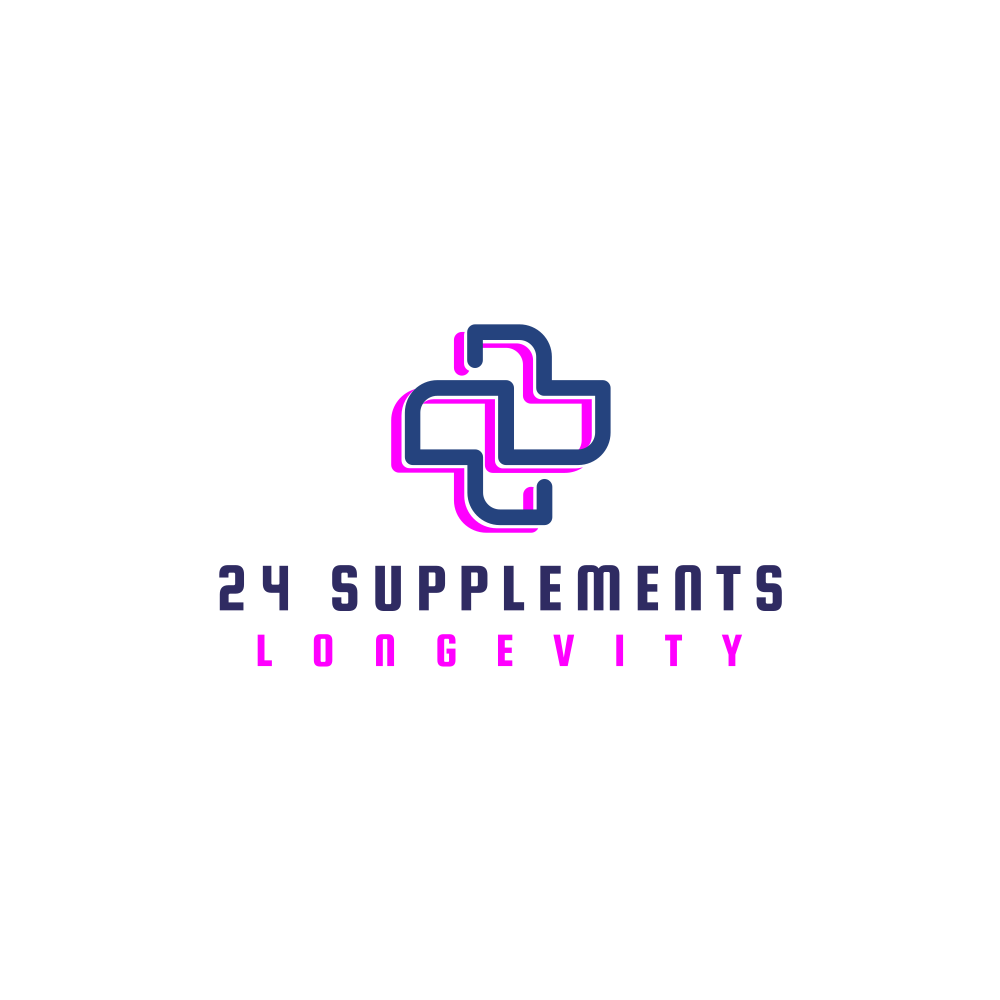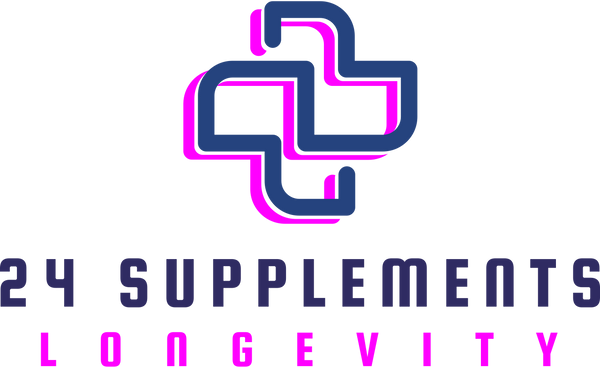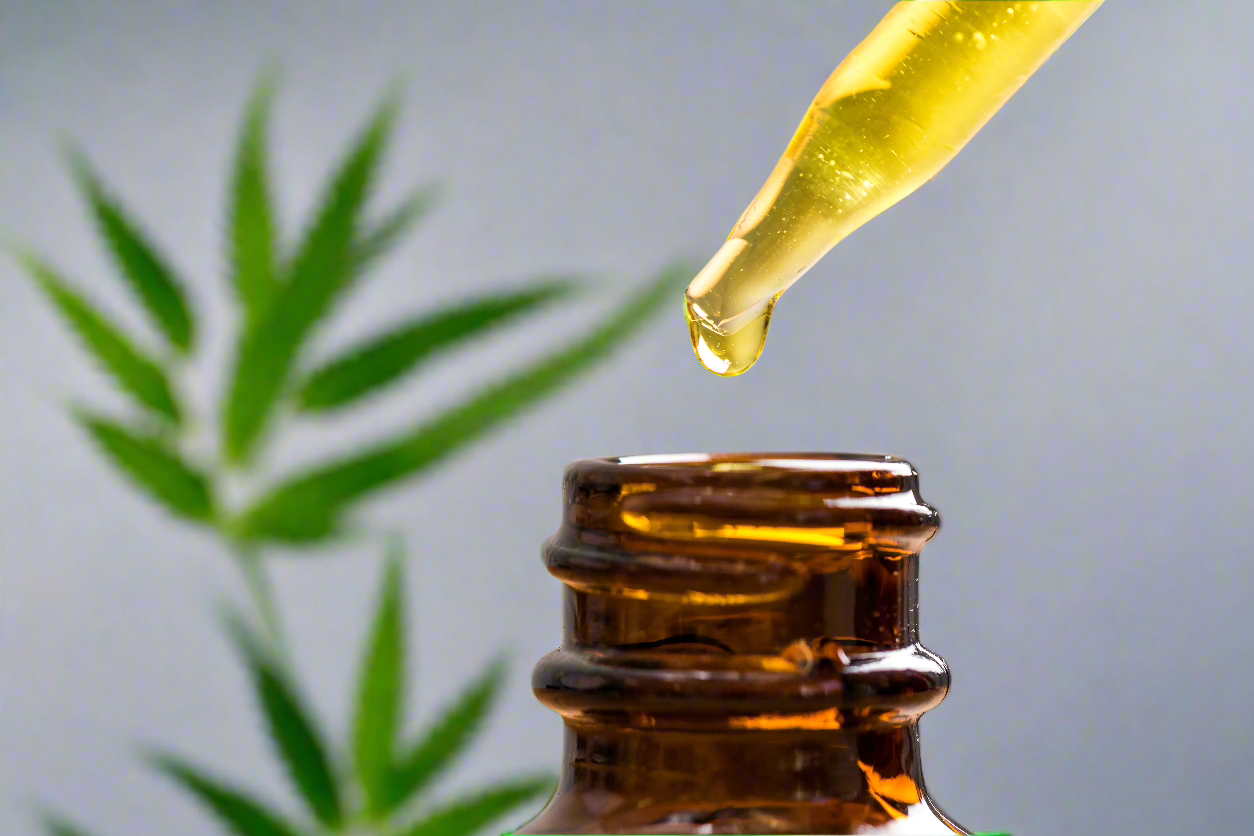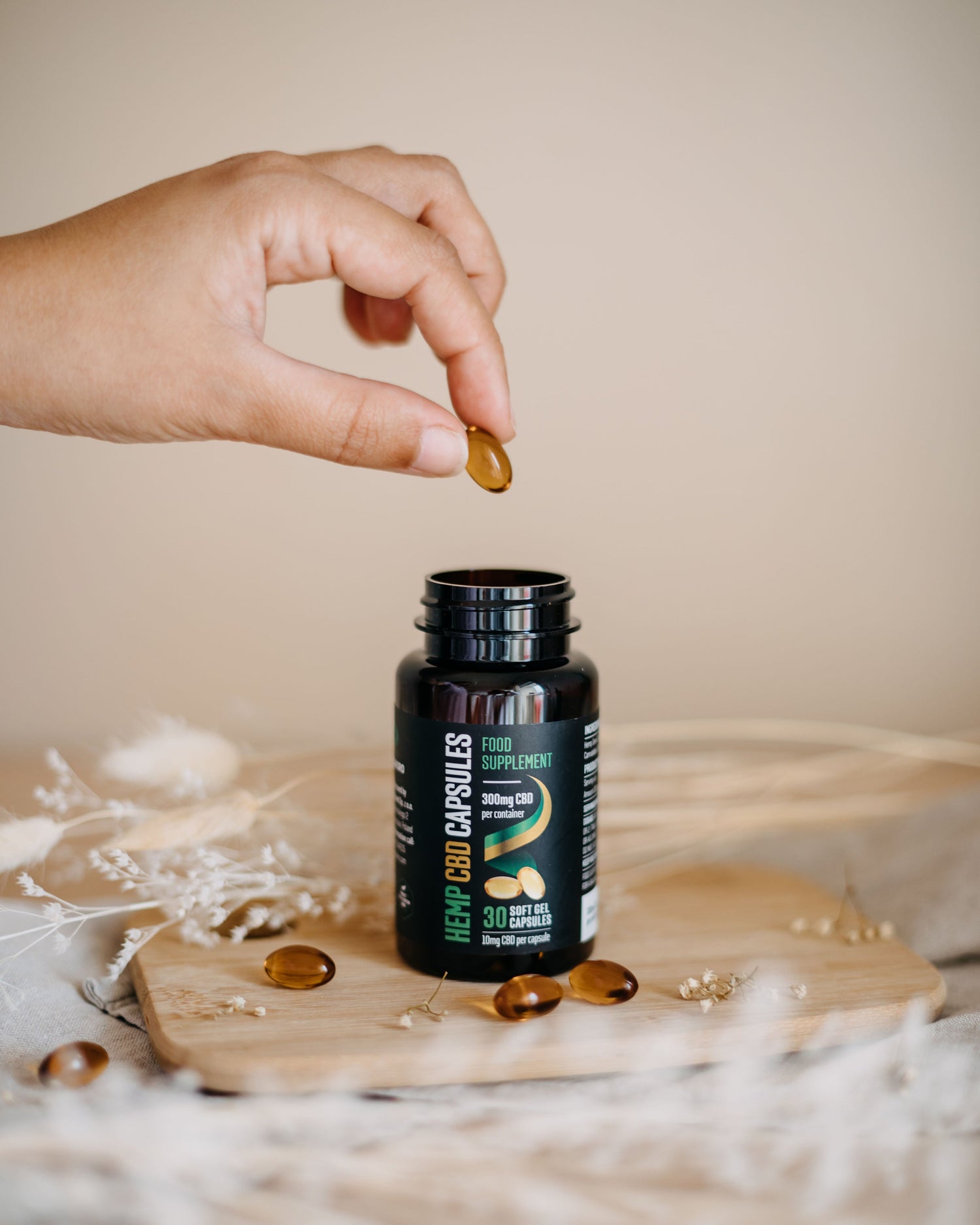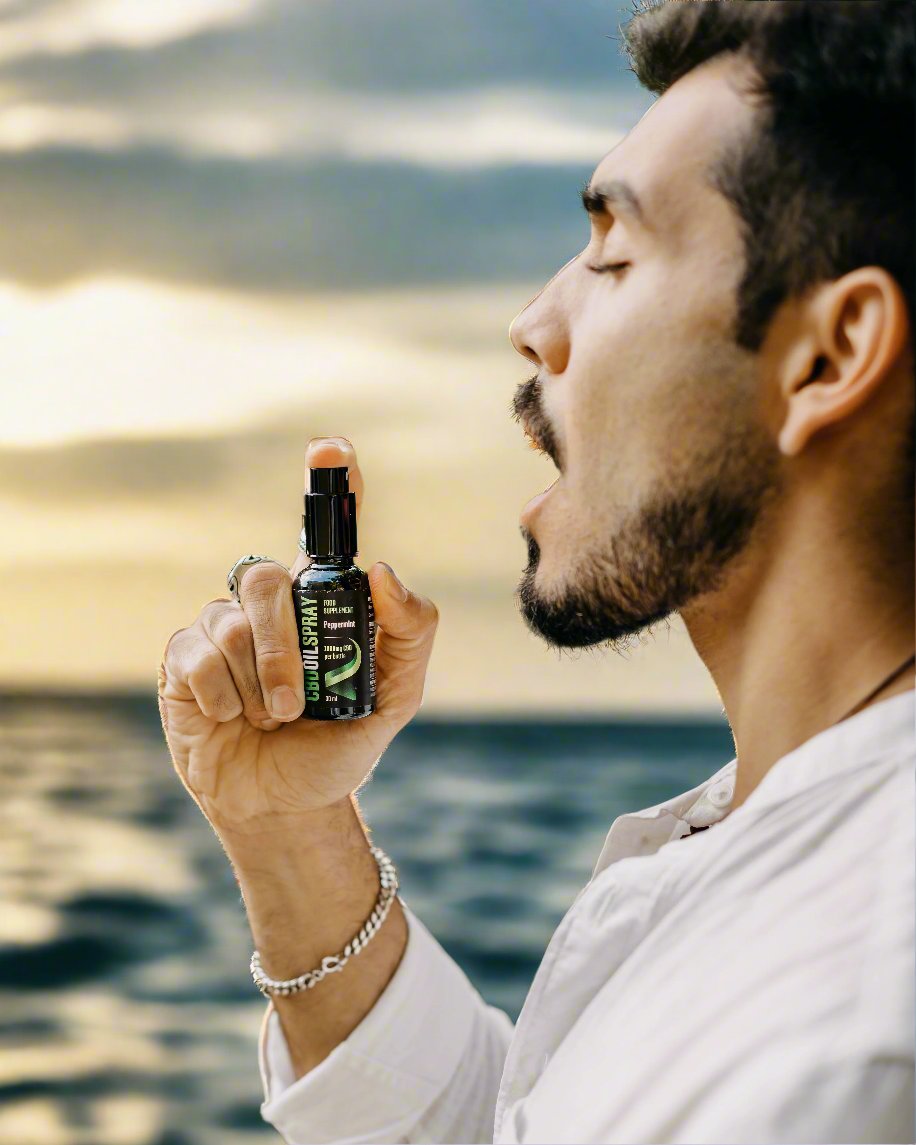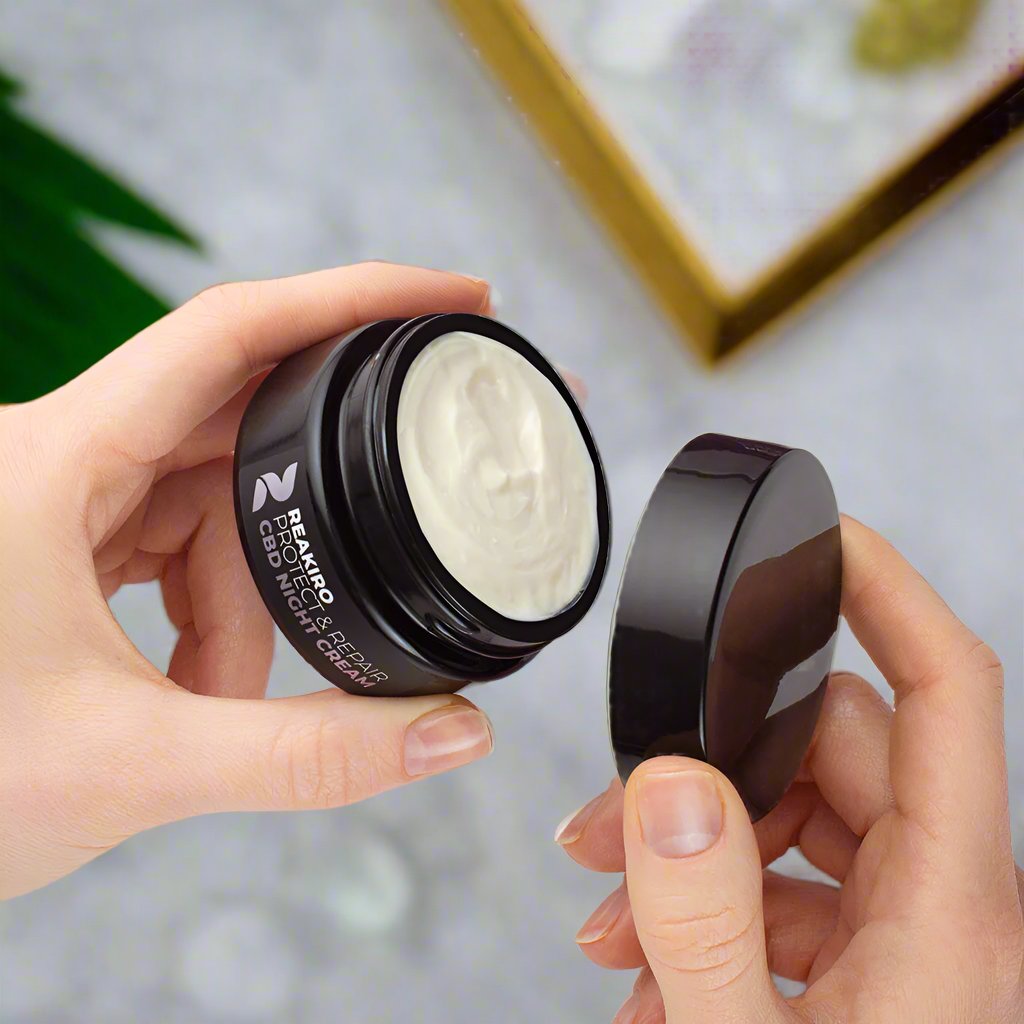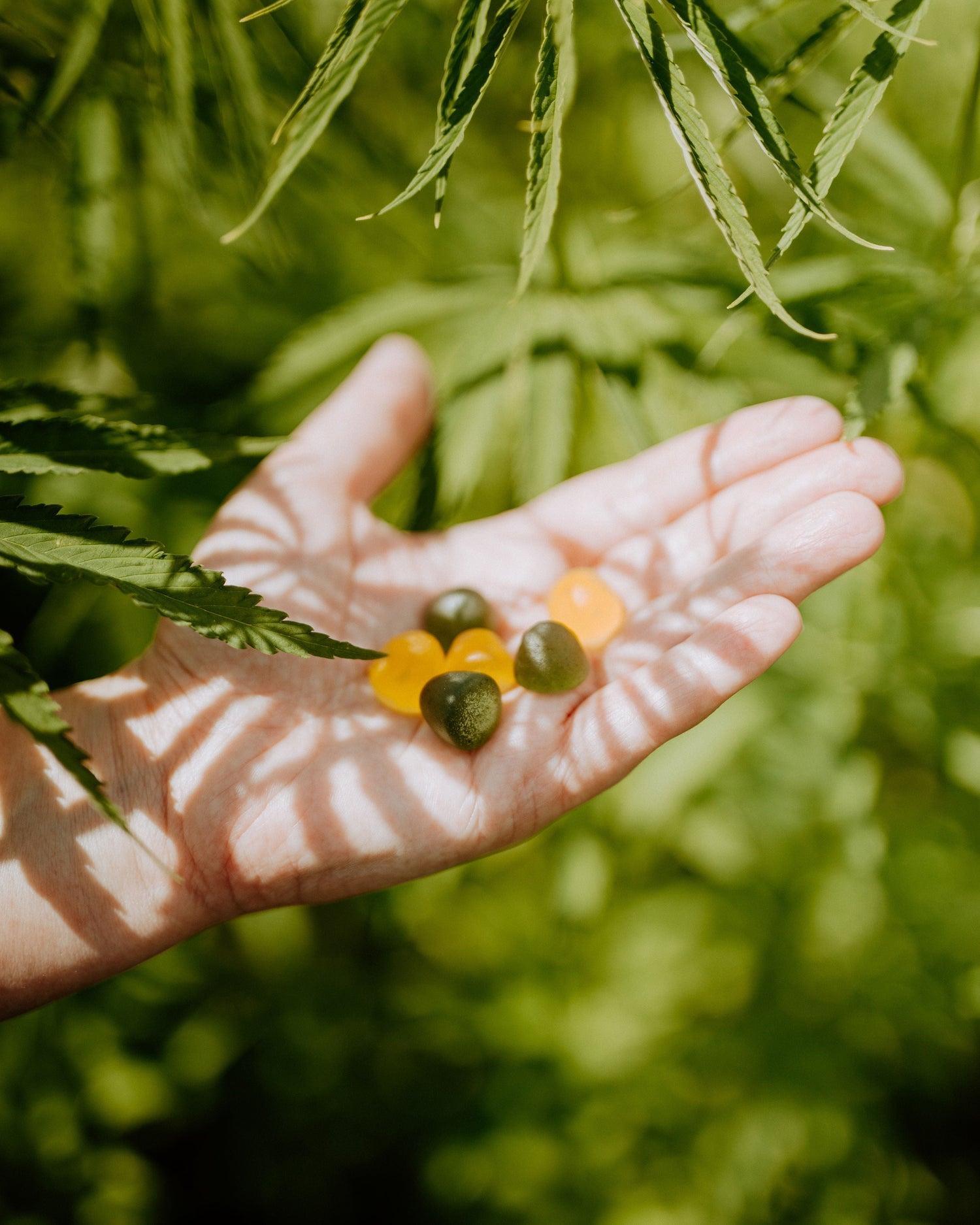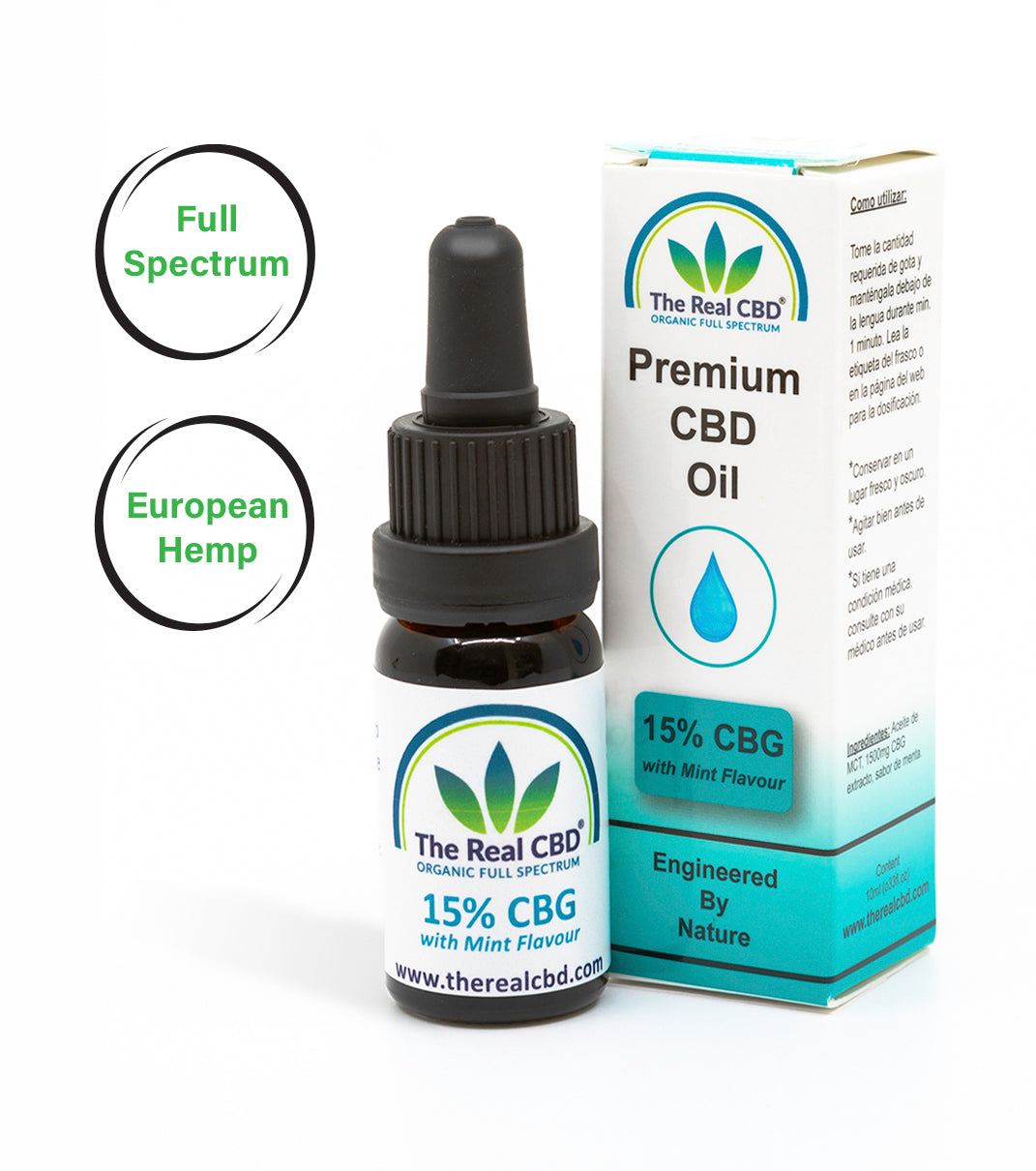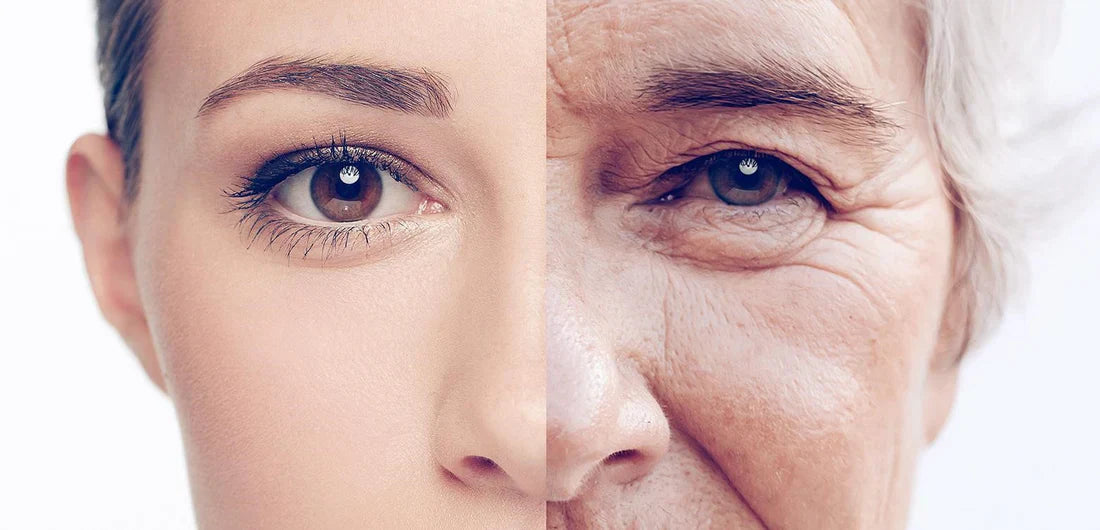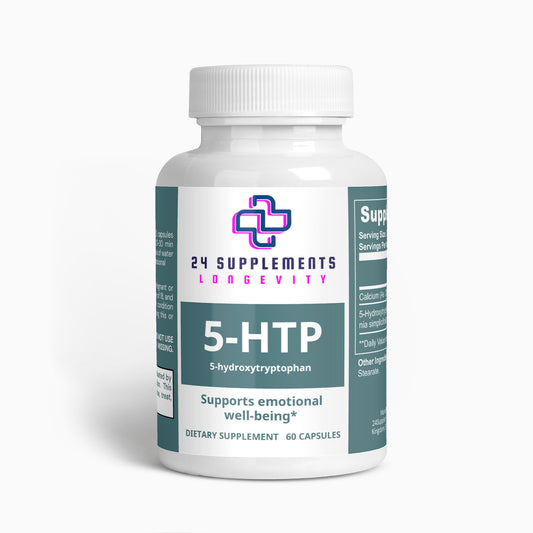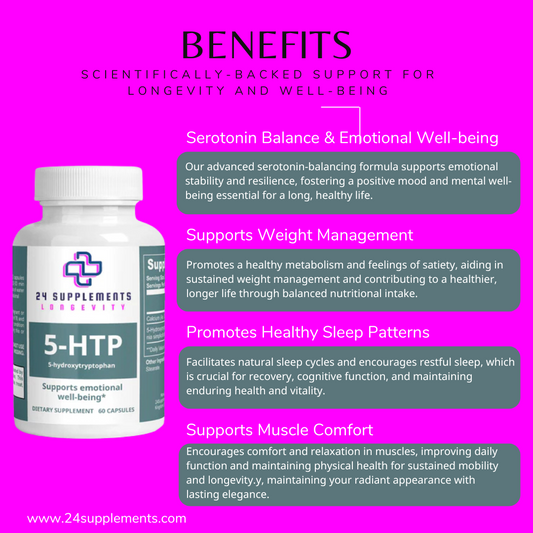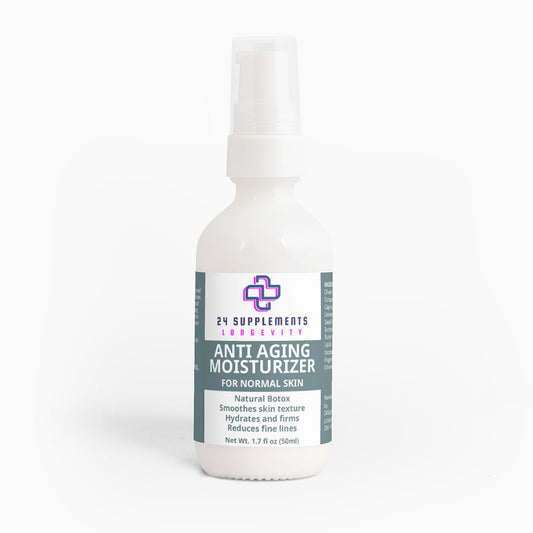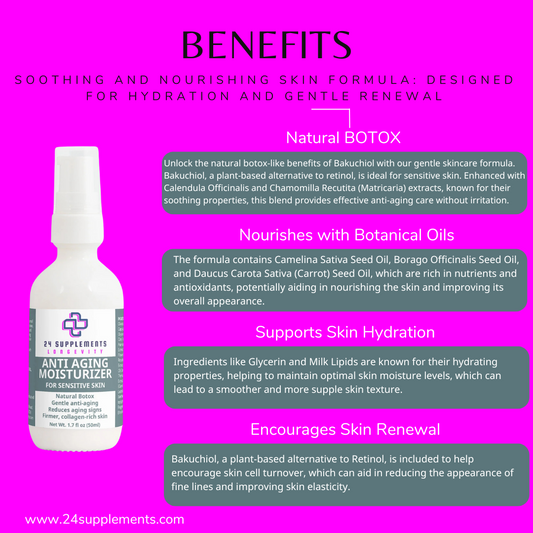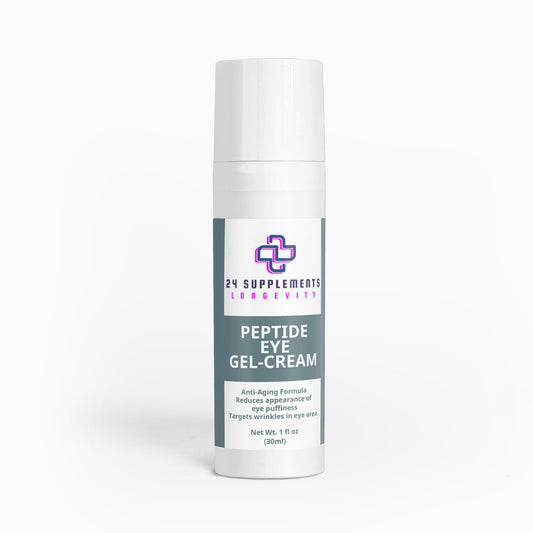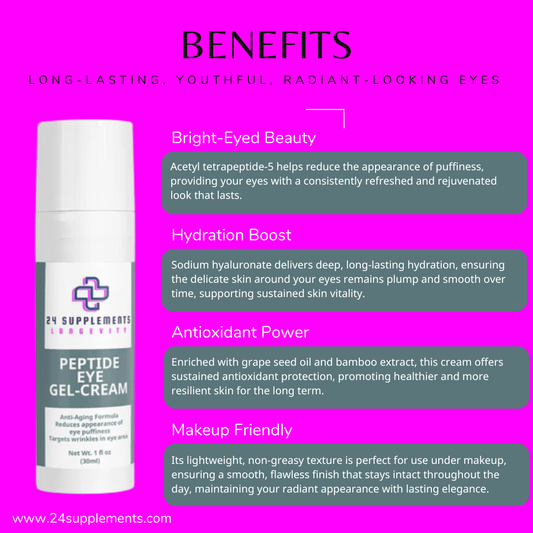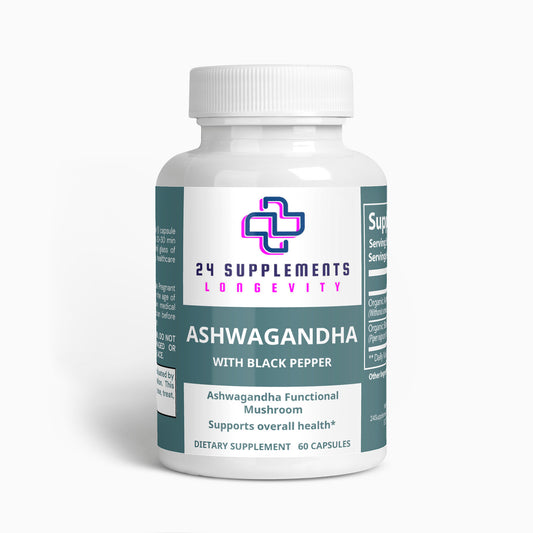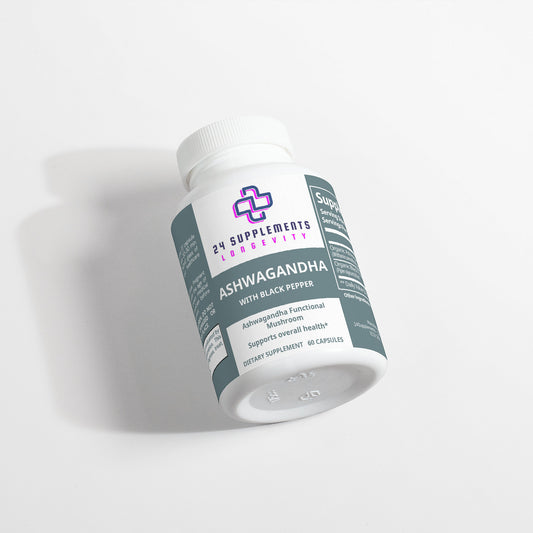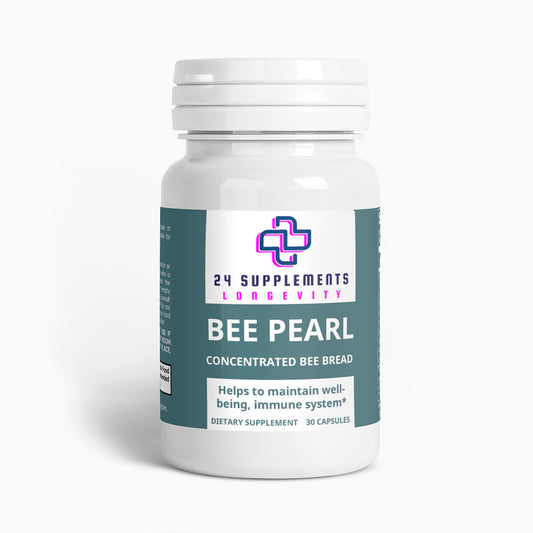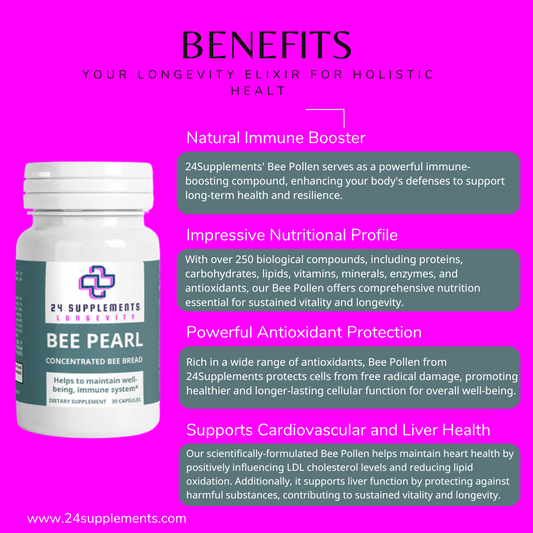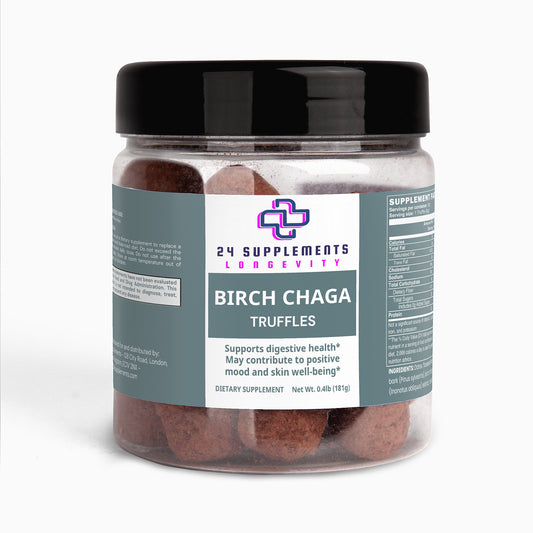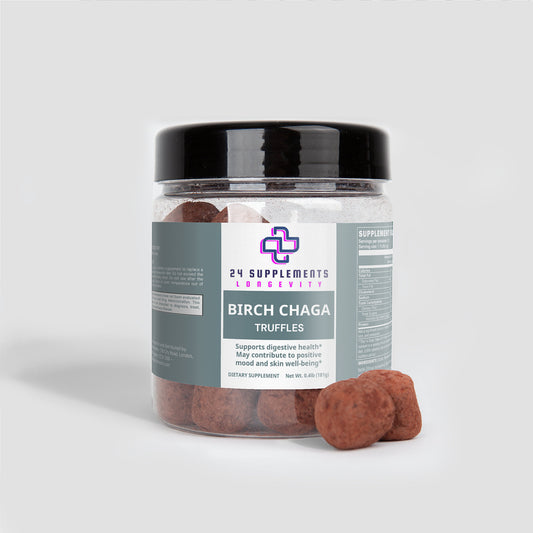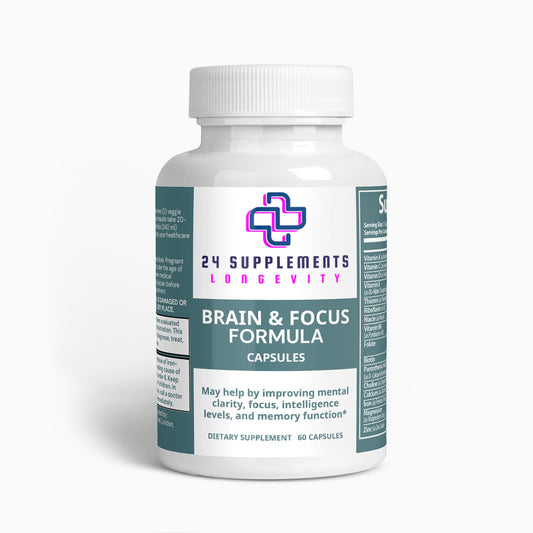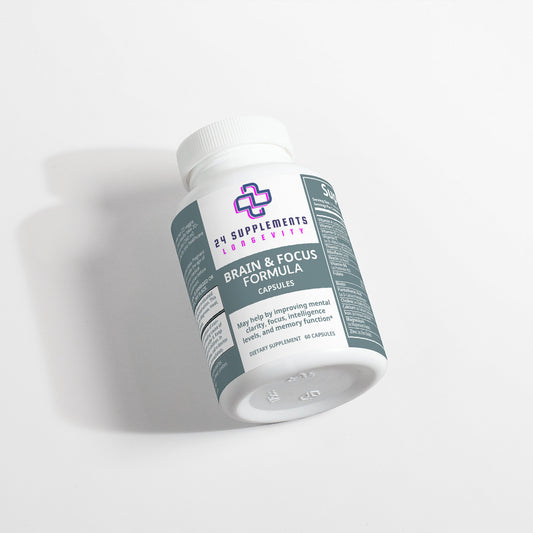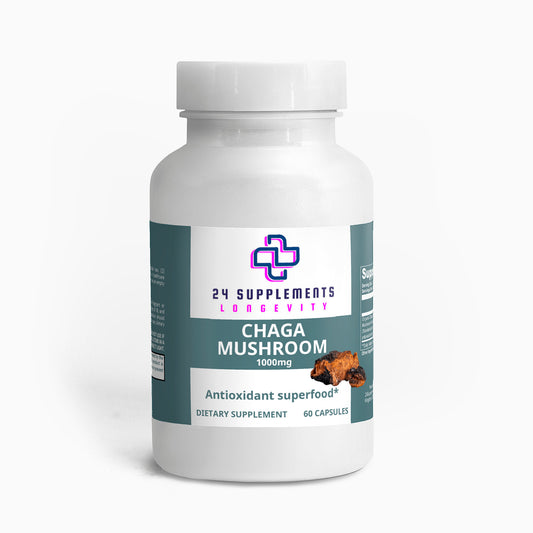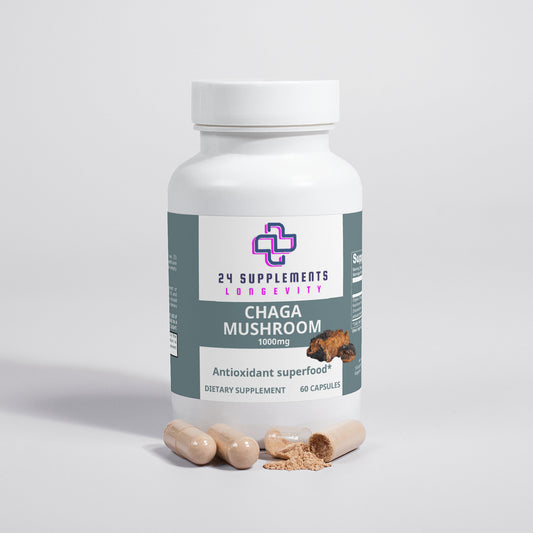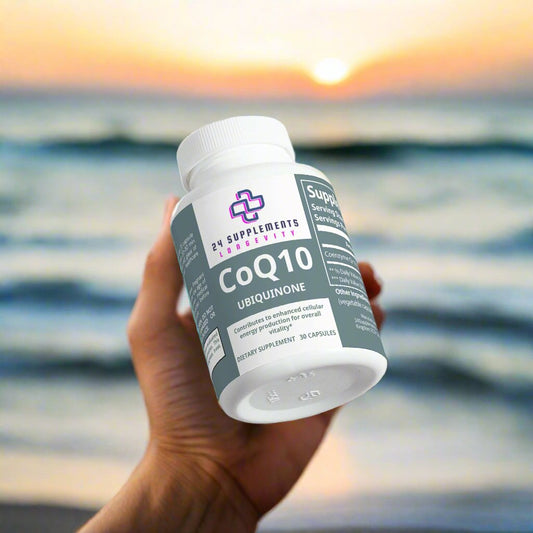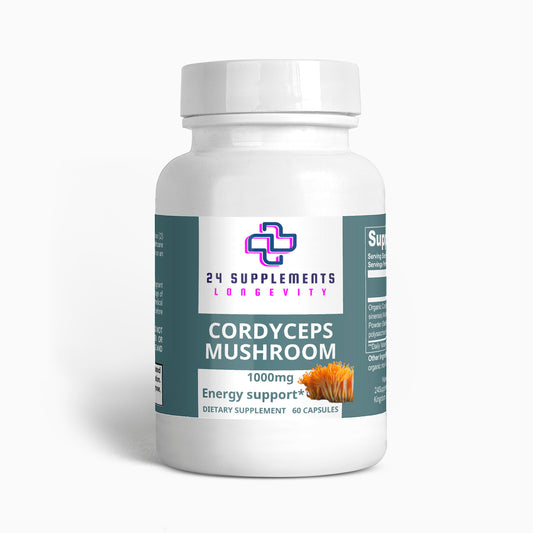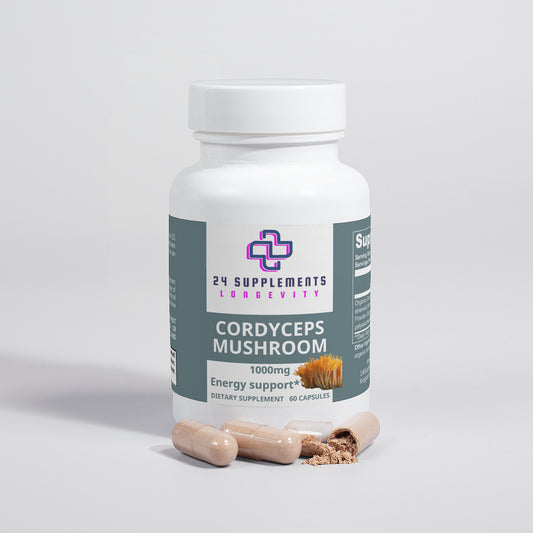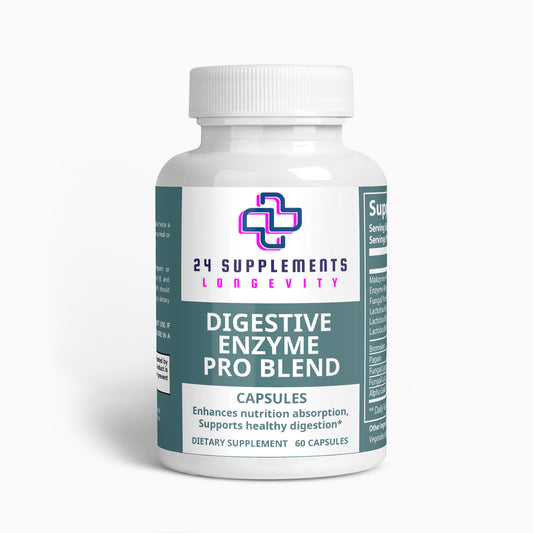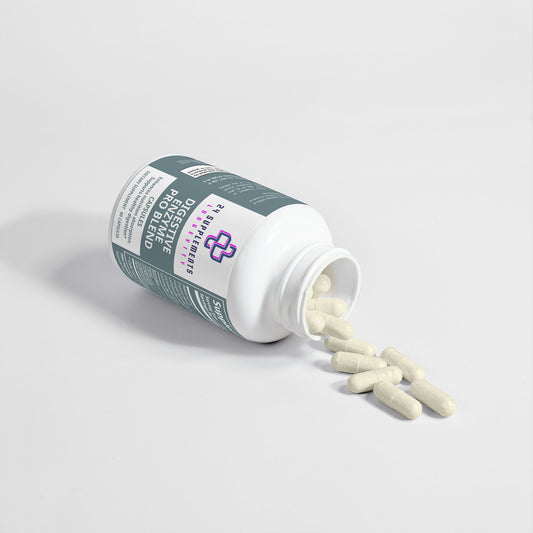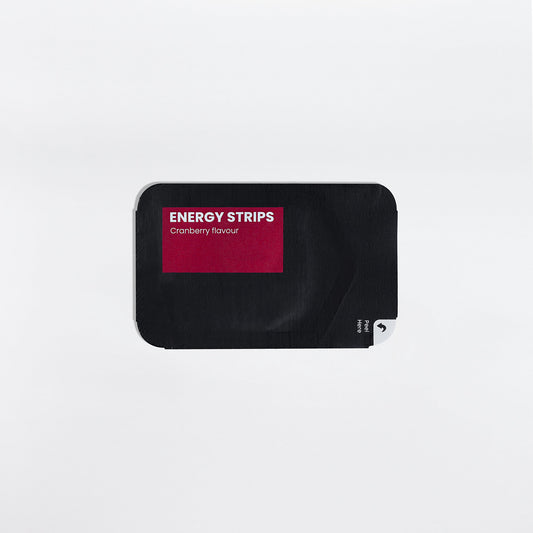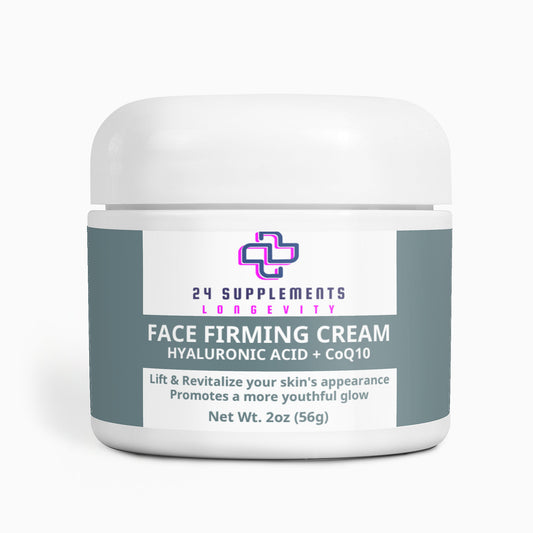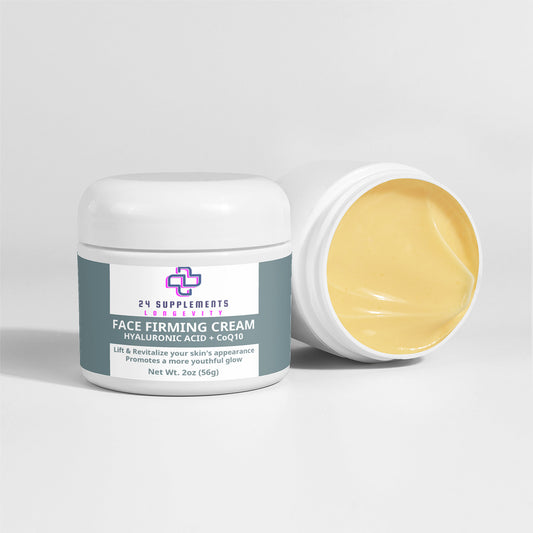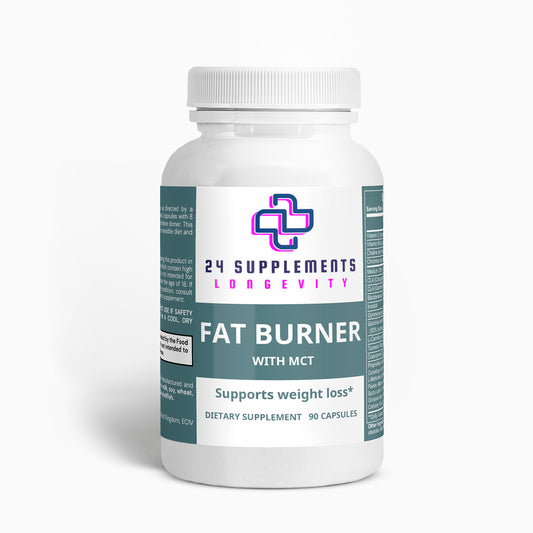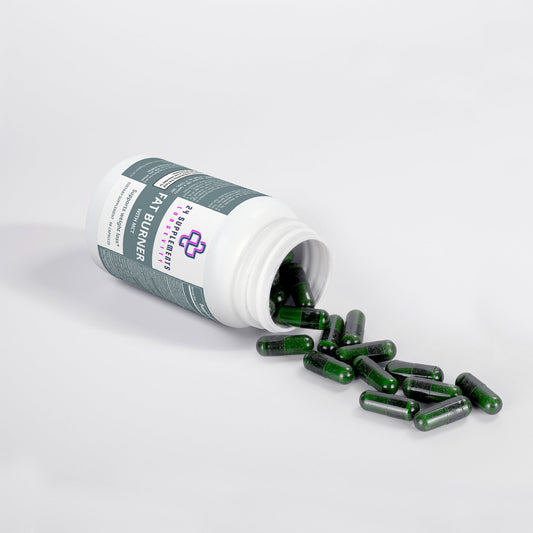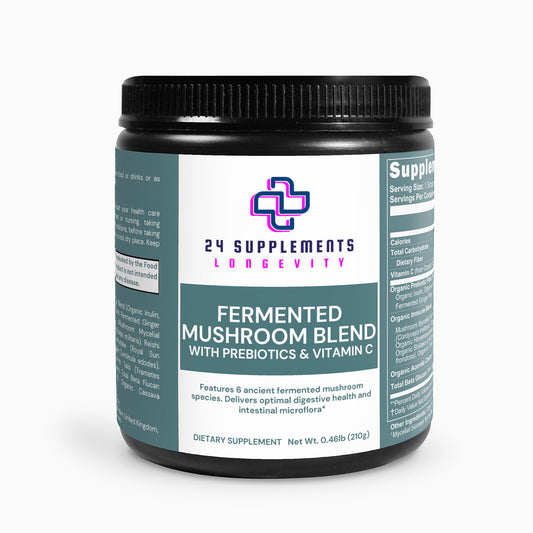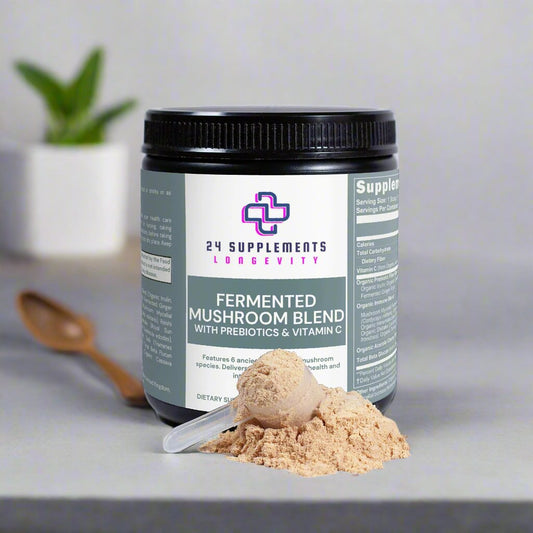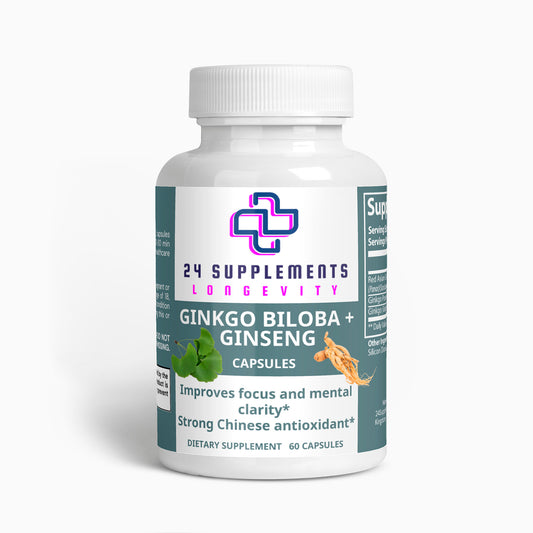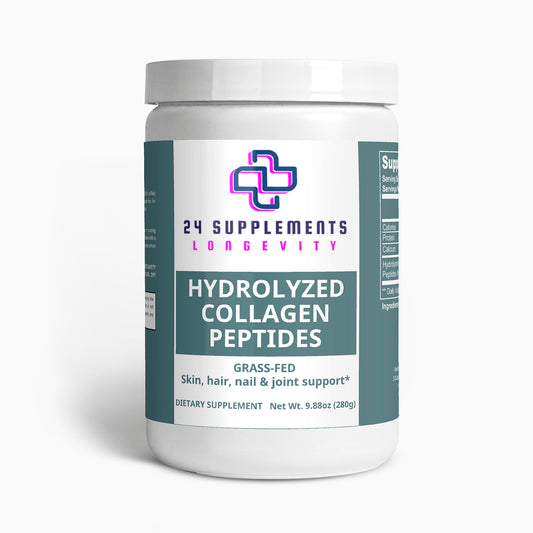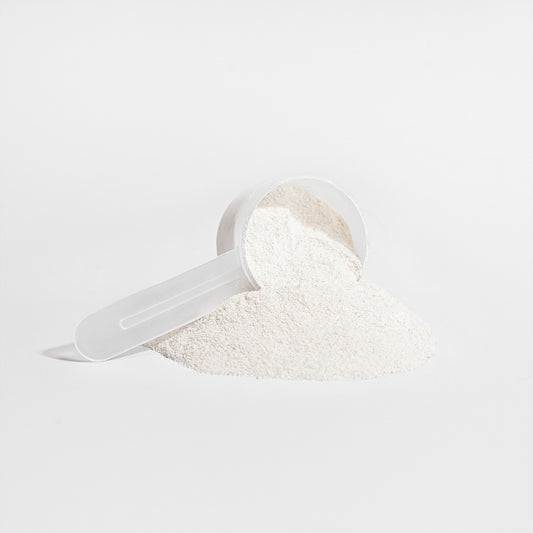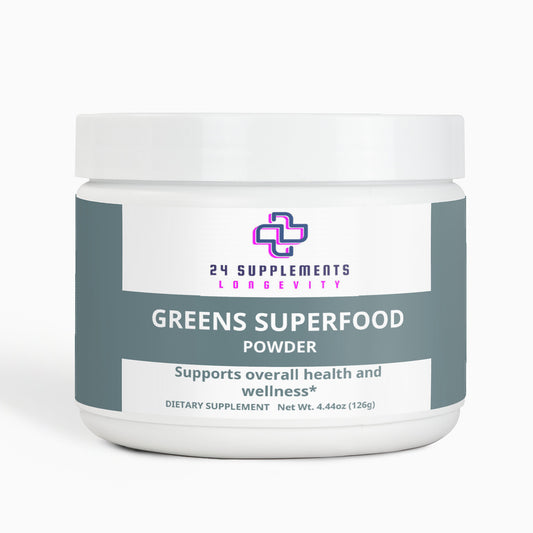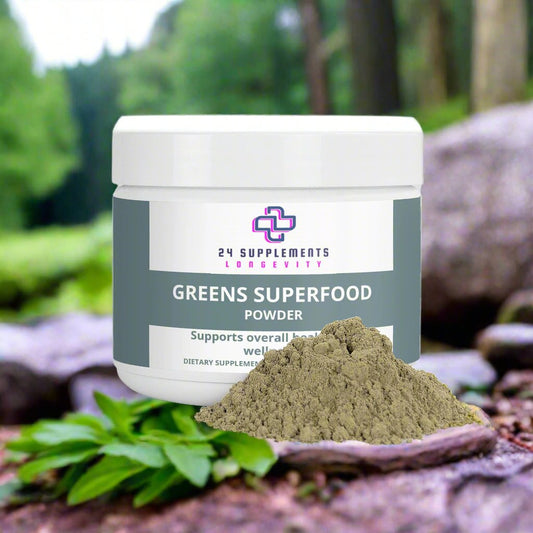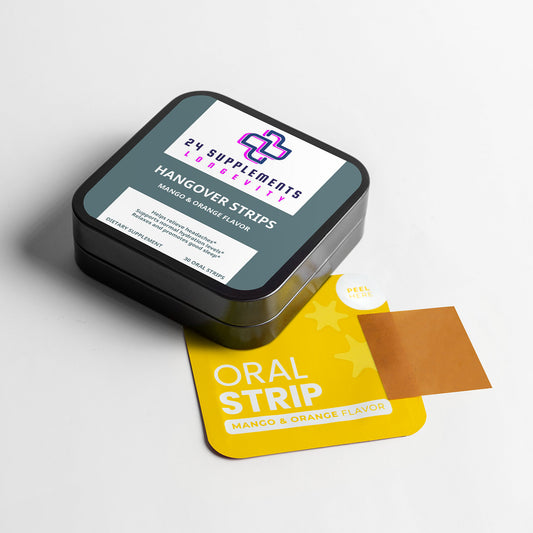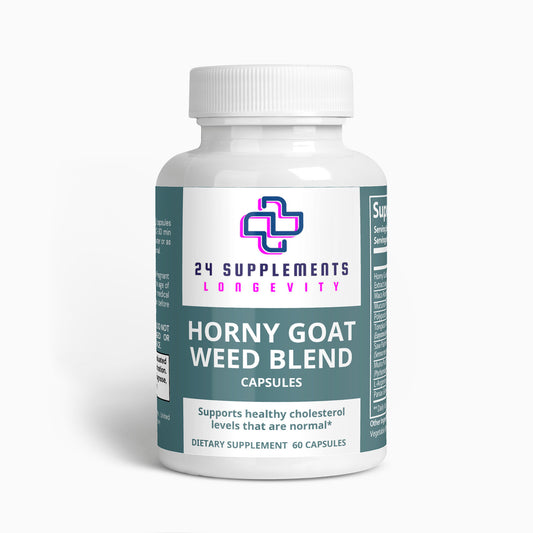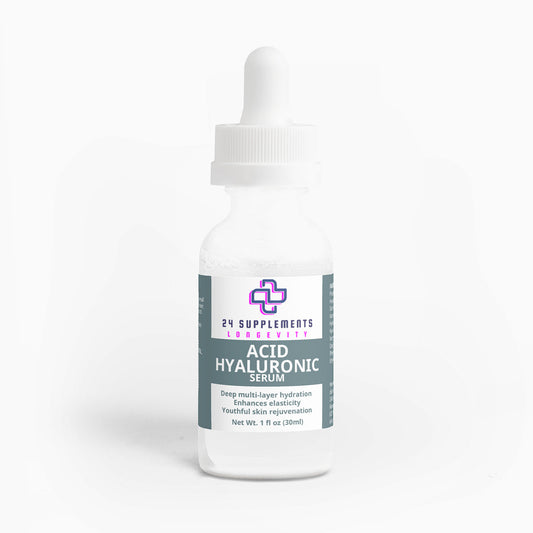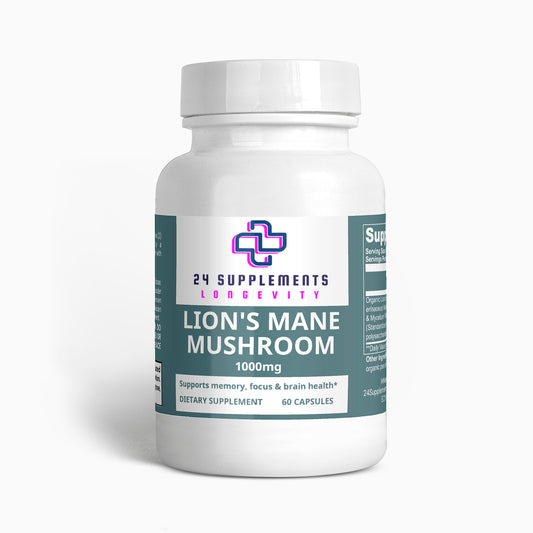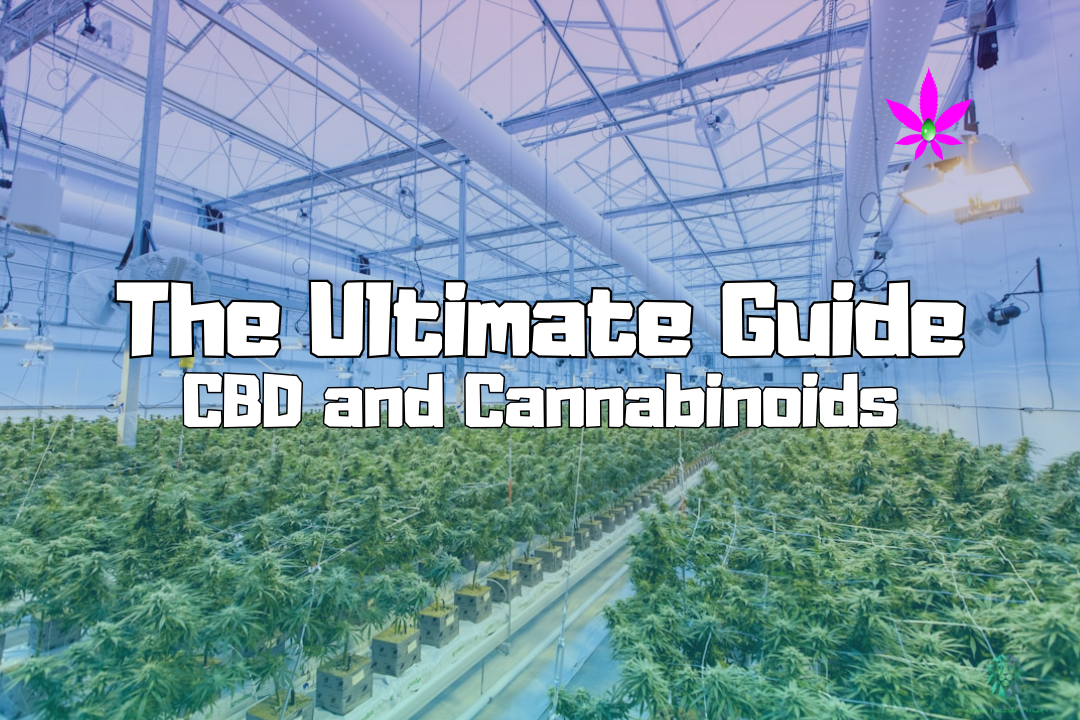
Ultimate Guide to CBD and Cannabinoids
Share
Chapter 1: What is CBD?
CBD (Cannabidiol) is a naturally occurring compound found in the cannabis plant. Unlike its more famous cousin, THC (Tetrahydrocannabinol), CBD is non-psychoactive, meaning it doesn’t produce a “high.” Instead, CBD is widely recognized for its potential therapeutic benefits, making it a popular choice for managing anxiety, pain, inflammation, and a variety of other health conditions.
CBD interacts with the endocannabinoid system (ECS), a complex cell-signaling system in the human body that plays a crucial role in regulating a variety of physiological processes such as mood, sleep, appetite, and immune response. The ECS consists of endocannabinoids, receptors (CB1 and CB2), and enzymes that break down cannabinoids. CBD indirectly influences this system by enhancing the body’s natural ability to maintain balance (homeostasis).
Where Does CBD Come From?
CBD is primarily extracted from hemp, a variety of the cannabis plant that contains less than 0.3% THC, making it legal in many countries. In contrast, marijuana, another type of cannabis plant, contains much higher levels of THC. Hemp-derived CBD offers the same potential health benefits without the psychoactive effects of THC.
Why is CBD So Popular?
CBD has gained massive popularity because of its wide range of potential therapeutic applications. Whether you’re looking to reduce stress, manage chronic pain, or improve sleep, CBD is seen as a natural alternative to pharmaceutical drugs with fewer side effects. The versatility of CBD allows it to be incorporated into various forms such as oils, capsules, gummies, topicals, and even skincare products.
Potential Benefits of CBD:
- Anxiety and Stress Relief: Research has shown that CBD may help regulate serotonin levels, a neurotransmitter that plays a role in mood and anxiety. This makes CBD a popular choice for those dealing with generalized anxiety disorder (GAD), social anxiety, and stress.
- Pain Management: CBD’s anti-inflammatory properties make it effective for managing chronic pain, including arthritis, nerve pain, and muscle soreness.
- Improved Sleep: By reducing anxiety and relieving pain, CBD can improve sleep quality, making it an alternative for those suffering from insomnia or sleep disturbances.
- Anti-inflammatory Effects: CBD is commonly used to reduce inflammation, which is linked to a variety of conditions such as acne, arthritis, and other autoimmune disorders.
How is CBD Used?
CBD is versatile and can be consumed in various ways depending on your needs and preferences:
- CBD Oil/Tinctures: Taken sublingually (under the tongue), CBD oil is absorbed quickly and offers fast relief. It’s one of the most common and effective ways to take CBD.
- CBD Capsules: Pre-measured capsules are easy to incorporate into your daily routine, offering slow-release effects for longer-lasting relief.
- CBD Gummies/Edibles: Tasty and convenient, edibles provide pre-dosed CBD, but their effects may take longer to kick in due to digestion.
- CBD Topicals: Balms, lotions, and creams infused with CBD can be applied directly to the skin for targeted relief, making them ideal for localized pain or skin conditions.
- CBD Vape: Provides fast-acting relief, but the effects may not last as long as other forms.
The Science Behind CBD’s Effectiveness
CBD works by interacting with CB1 and CB2 receptors in the body’s ECS. While THC binds directly to CB1 receptors in the brain, causing psychoactive effects, CBD interacts indirectly with both CB1 and CB2 receptors, influencing the ECS without producing a high. This allows CBD to modulate pain perception, reduce inflammation, and regulate mood without altering one’s state of mind.
CBD also impacts other receptors, such as serotonin receptors, which play a role in mood regulation, and vanilloid receptors, which are involved in pain perception.
CBD vs. THC: The Key Differences
CBD is non-psychoactive, meaning it doesn’t cause a high. It is used primarily for therapeutic purposes like managing pain, anxiety, and inflammation.
THC, on the other hand, is the psychoactive compound in cannabis responsible for the high. While THC also has therapeutic properties, its psychoactive effects make it less desirable for daily use compared to CBD.
Is CBD Legal?
In many countries, CBD is legal as long as it contains less than a certain percentage of THC (0.2% in the EU, 0.3% in the U.S., and up to 1% in Switzerland). However, it’s always important to check local laws and regulations as they can vary by region.
Choosing the Right CBD Product
When selecting a CBD product, it’s important to consider factors such as the concentration of CBD, the type of product (oil, gummies, capsules), and the quality of the product. At 24Supplements, we ensure all our CBD products are third-party lab tested, guaranteeing purity, potency, and compliance with legal THC limits.
Shop High-Quality CBD Products
Chapter 2: Full Spectrum, Broad Spectrum, Isolate, Distillate, Raw Oil, and Extract
CBD products come in various formulations, each offering different benefits based on the range of cannabinoids and compounds they contain. The key differences among full spectrum, broad spectrum, isolate, distillate, raw oil, and extract products lie in the presence of additional cannabinoids, terpenes, and THC.
What is Full Spectrum CBD?
Full spectrum CBD contains all the naturally occurring compounds found in the hemp plant, including cannabinoids, terpenes, flavonoids, and trace amounts of THC (typically less than 0.3%). This combination of compounds works together to create what is known as the entourage effect, enhancing the therapeutic benefits of CBD.
Benefits of Full Spectrum CBD:
- Offers the full range of cannabinoids and terpenes for enhanced effects.
- Best for users seeking a complete, natural hemp experience.
- May be more effective for chronic pain and inflammation due to the entourage effect.
Shop Full Spectrum CBD Products
What is Broad Spectrum CBD?
Broad spectrum CBD is similar to full spectrum CBD but without THC. It contains multiple cannabinoids, terpenes, and flavonoids, providing many of the benefits of full spectrum products without the risk of consuming THC. Broad spectrum is ideal for users who want the benefits of the entourage effect without any THC.
Benefits of Broad Spectrum CBD:
- Provides multiple cannabinoids and terpenes without THC.
- Suitable for those who want to avoid THC for personal or legal reasons.
- May offer benefits for anxiety, stress, and pain relief.
Shop Broad Spectrum CBD Products
What is CBD Isolate?
CBD isolate is the purest form of CBD, containing 99% CBD with no other cannabinoids, terpenes, or THC. It’s ideal for users who want to avoid all other cannabis compounds and focus solely on the benefits of CBD. Isolate products are often tasteless and odorless, making them easy to incorporate into various products such as food or drinks.
Benefits of CBD Isolate:
- Pure CBD with no other compounds.
- Great for users who are sensitive to THC or other cannabinoids.
- Offers versatile use in edibles, drinks, or direct consumption.
What is CBD Distillate?
CBD distillate is a highly refined, concentrated form of CBD that retains multiple cannabinoids and terpenes but with very low THC content. It's more refined than full-spectrum oil and is often used in products like vapes, edibles, and topicals. Distillate products provide a potent dose of cannabinoids without the full THC content of full-spectrum products.
Benefits of CBD Distillate:
- Retains cannabinoids and terpenes for enhanced effects.
- Often used in vapes and topicals for fast-acting relief.
- Ideal for users seeking potency without significant THC.
What is Raw CBD Oil?
Raw CBD oil refers to unrefined or minimally processed CBD oil. It’s typically dark in color and retains all cannabinoids, terpenes, chlorophyll, and other naturally occurring compounds found in the hemp plant. Because it’s less processed, raw CBD oil has a more natural, earthy flavor and offers the full range of the plant’s beneficial compounds.
Benefits of Raw CBD Oil:
- Contains the full range of cannabinoids and terpenes.
- Offers a less processed, more natural product.
- May contain chlorophyll and other plant compounds that are lost in refined oils.
What is CBD Extract?
CBD extract is a broad term used to describe any concentrated form of cannabidiol derived from the cannabis plant. It can refer to both isolated CBD and full-spectrum or broad-spectrum oils. CBD extract is the base material used to create a variety of CBD products, from tinctures to topicals and edibles.
Benefits of CBD Extract:
- Can be used in a wide range of product formulations.
- Available in full-spectrum, broad-spectrum, or isolate forms.
- Highly versatile and used as the foundation for many CBD products.
Choosing the Right CBD Product
Choosing between full spectrum, broad spectrum, isolate, distillate, raw oil, and extract depends on your specific needs and preferences. If you’re looking for the full benefits of the entourage effect, full spectrum is the best choice. For those who want to avoid THC, broad spectrum is ideal. If you want pure CBD without any other compounds, isolate is the way to go. Distillate offers a potent and versatile option for users looking for concentrated cannabinoids without the full THC content. Raw oil provides a more natural, unrefined option, while extract serves as a foundation for various product forms.
Explore Our Full Range of CBD Products
Chapter 3: What are Terpenes?
Terpenes are natural compounds found in many plants, including hemp and cannabis. They are responsible for the unique scents and flavors of the plant, but they also offer a range of therapeutic benefits that can enhance the effects of cannabinoids like CBD. When combined with cannabinoids, terpenes contribute to what is known as the entourage effect, meaning the compounds work synergistically to boost the overall benefits of the product.
Types of Terpenes Found in CBD Products
Here are some of the most common terpenes found in CBD products and their potential effects:
1. Myrcene
Myrcene is one of the most common terpenes found in cannabis. It has a musky, earthy scent and is known for its relaxing and sedative effects. Myrcene can help enhance CBD's calming properties, making it ideal for those seeking stress relief or better sleep.
- Benefits: Anti-inflammatory, analgesic (pain relief), and sedative effects.
- Commonly Found In: Mangoes, lemongrass, thyme, and basil.
2. Limonene
Limonene is known for its citrusy scent and uplifting properties. It’s commonly used in aromatherapy for mood enhancement and is known to help reduce stress and anxiety.
- Benefits: Anti-anxiety, mood enhancement, and anti-inflammatory effects.
- Commonly Found In: Citrus fruits like lemons, oranges, and limes.
3. Pinene
Pinene is another common terpene, characterized by its pine-like aroma. It’s known to help improve alertness, memory retention, and respiratory function, making it ideal for focus and productivity.
- Benefits: Anti-inflammatory, bronchodilator (improves breathing), and cognitive enhancement.
- Commonly Found In: Pine needles, rosemary, and parsley.
4. Linalool
Linalool is responsible for the lavender-like scent in cannabis. It is well-known for its calming and anti-anxiety effects, often used to promote relaxation and better sleep. Linalool is commonly used in aromatherapy to reduce stress.
- Benefits: Anti-anxiety, sedative, and anti-inflammatory properties.
- Commonly Found In: Lavender, mint, and cinnamon.
5. Beta-Caryophyllene
Beta-caryophyllene is a spicy, peppery terpene commonly found in black pepper, cloves, and cinnamon. It is unique because it interacts directly with the body's CB2 receptors, making it highly effective for reducing inflammation and pain.
- Benefits: Anti-inflammatory, pain relief, and potential neuroprotective properties.
- Commonly Found In: Black pepper, cloves, and cinnamon.
The Entourage Effect: How Terpenes Enhance CBD
The entourage effect refers to the synergy between cannabinoids and terpenes, where they work together to enhance the therapeutic benefits of CBD. For example, combining CBD with limonene and linalool can increase its ability to reduce stress and anxiety, while pinene may improve alertness and memory. Full-spectrum and broad-spectrum CBD products take advantage of the entourage effect by retaining multiple cannabinoids and terpenes from the hemp plant.
Choosing the Right Terpene Profile
When selecting a CBD product, it's important to consider which terpenes are present and their effects. For example, if you’re looking for help with sleep, a product rich in myrcene and linalool may be more effective. If you need more energy and focus, a product with limonene and pinene might be ideal. Always check the product’s lab report or label for a breakdown of the terpenes present.
Explore CBD Products with Terpenes
Chapter 4: Cannabinoids – CBG, CBN, CBC, THC
Cannabinoids are the active compounds found in cannabis and hemp plants. While CBD and THC are the most well-known, several other cannabinoids offer unique therapeutic benefits. In this chapter, we explore the properties and uses of key cannabinoids, including CBG (Cannabigerol), CBN (Cannabinol), CBC (Cannabichromene), and THC (Tetrahydrocannabinol).
What is CBG (Cannabigerol)?
CBG is often referred to as the "mother cannabinoid" because it is the precursor from which other cannabinoids, like CBD and THC, are synthesized. Though found in smaller quantities than CBD or THC, CBG has shown great promise in research for its potential benefits in areas such as pain relief, anti-inflammatory effects, and neuroprotection.
Potential Benefits of CBG:
- Anti-inflammatory: CBG has been found to reduce inflammation, making it useful for conditions like inflammatory bowel disease.
- Neuroprotective: Studies suggest CBG may help protect nerve cells, with possible benefits for neurodegenerative conditions.
- Glaucoma Relief: CBG may help reduce intraocular pressure, making it potentially beneficial for glaucoma.
What is CBN (Cannabinol)?
CBN is known primarily for its sedative effects, making it popular for those who have trouble sleeping. Unlike THC, CBN is non-psychoactive, meaning it won’t produce a “high,” but it has shown promise as a natural sleep aid and for its ability to stimulate appetite.
Potential Benefits of CBN:
- Sleep Aid: CBN is often used in products designed to help with insomnia and sleep disturbances.
- Pain Relief: Like other cannabinoids, CBN has anti-inflammatory properties that may help with chronic pain.
- Appetite Stimulant: CBN has been shown to increase appetite, making it useful for people who struggle with appetite loss.
What is CBC (Cannabichromene)?
CBC is a lesser-known cannabinoid that offers promising anti-inflammatory and pain-relief properties without the psychoactive effects of THC. It works by interacting with the body’s TRPV1 receptors, which are linked to pain perception, and also influences the body’s endocannabinoid system by increasing the availability of natural endocannabinoids like anandamide.
Potential Benefits of CBC:
- Pain Relief: CBC has shown promise in reducing pain by interacting with the body’s pain receptors.
- Anti-inflammatory: Like CBD and CBG, CBC has anti-inflammatory properties that may benefit those with conditions like arthritis.
- Neuroprotection: CBC may also have neuroprotective benefits, helping to prevent damage to nerve cells.
What is THC (Tetrahydrocannabinol)?
THC is the most well-known cannabinoid due to its psychoactive properties, which cause the “high” typically associated with cannabis use. While it is psychoactive, THC also offers several medical benefits, particularly for pain relief, appetite stimulation, and nausea reduction. In countries where THC is legal or regulated, it is used for medicinal purposes in a range of conditions.
Potential Benefits of THC:
- Pain Relief: THC is highly effective in managing chronic and acute pain.
- Appetite Stimulant: THC is often used to stimulate appetite, particularly in patients undergoing treatments like chemotherapy.
- Anti-nausea: THC has been widely used for its anti-nausea effects, particularly in cancer patients.
Explore Full-Spectrum Products Containing THC
Understanding the Entourage Effect with Cannabinoids
Each of these cannabinoids interacts with the body’s endocannabinoid system in different ways, but when used together, they can create what is known as the entourage effect. This means that the cannabinoids work synergistically, enhancing each other’s effects to provide a more comprehensive therapeutic outcome. Full-spectrum and broad-spectrum CBD products capitalize on the entourage effect by retaining multiple cannabinoids.
Choosing the Right Cannabinoid for Your Needs
Choosing the right cannabinoid depends on your individual needs. For sleep and relaxation, CBN may be the best choice. For pain relief and inflammation, CBG and CBC are great options. If you’re looking for full therapeutic benefits, including some psychoactive effects, THC might be suitable (where legal). Full-spectrum products that contain a mix of these cannabinoids offer the widest range of benefits due to the entourage effect.
Shop Full-Spectrum and Cannabinoid-Specific Products
Chapter 5: Research and Scientific Studies on CBD
Overview of CBD Research
CBD has garnered significant interest within the scientific community for its wide range of potential health benefits. As research continues, several studies have provided compelling evidence for CBD's efficacy in treating conditions such as anxiety, chronic pain, sleep disorders, and epilepsy. In this chapter, we will explore key studies and their findings to give a clearer picture of how CBD may be beneficial.
Anxiety and Stress Relief
One of the most well-researched applications of CBD is in the treatment of anxiety and stress. CBD interacts with the brain's serotonin receptors (specifically the 5-HT1A receptor), which plays a significant role in mood regulation.
- A 2011 study in Neuropsychopharmacology found that CBD significantly reduced anxiety in individuals with social anxiety disorder (SAD) during a public speaking test.
- A 2019 study published in The Permanente Journal reported that 79% of participants experienced a reduction in anxiety within the first month of CBD use.
For more information on CBD’s role in managing anxiety, visit our CBD for Anxiety guide.
Chronic Pain and Inflammation
CBD is well-known for its anti-inflammatory and pain-relieving properties, which can be useful for treating chronic pain conditions such as arthritis, fibromyalgia, and neuropathic pain.
- A 2018 review published in Frontiers in Pharmacology highlighted that CBD helps manage chronic pain by interacting with pain receptors and inhibiting the release of pro-inflammatory cytokines.
- A 2017 study in Pain found that CBD significantly reduced inflammatory and neuropathic pain in animal models, indicating its potential use for conditions like multiple sclerosis (MS) and sciatica.
To explore CBD products designed for pain relief, check out our CBD for Pain Relief collection.
Improved Sleep and Sleep Disorders
CBD has been shown to improve sleep quality, particularly for individuals suffering from anxiety or chronic pain, two common causes of sleep disturbances.
- A 2019 clinical study by The Permanente Journal found that 66% of participants reported improved sleep within the first month of CBD use. The study also noted CBD’s ability to reduce REM sleep disturbances.
For those struggling with sleep disorders, our CBD for Sleep range offers products specially formulated to promote better sleep.
Epilepsy and Seizure Management
One of the most well-established uses of CBD is in the treatment of epilepsy, particularly in children with Dravet syndrome and Lennox-Gastaut syndrome. In fact, Epidiolex, an FDA-approved CBD-based medication, is used specifically to treat these conditions.
- A 2017 study in The New England Journal of Medicine showed that children treated with Epidiolex experienced a 39% reduction in seizure frequency compared to a placebo group, demonstrating CBD’s efficacy in seizure management.
For more information about how CBD can be used to manage epilepsy, read our CBD for Epilepsy Guide.
Research on Other Cannabinoids
Research on other cannabinoids like CBG, CBN, and CBC is expanding, with preliminary studies suggesting their potential to offer anti-inflammatory, neuroprotective, and sedative properties. When combined with CBD, these cannabinoids create the entourage effect, amplifying the therapeutic potential of each compound.
- CBG: May reduce inflammation and protect nerve cells, making it a promising option for neurodegenerative diseases.
- CBN: Known for its sedative properties, CBN is gaining popularity as a natural sleep aid.
- CBC: Shows potential for pain relief and neuroprotection, especially when combined with other cannabinoids.
To learn more about these cannabinoids, check out our CBG, CBN, and CBC Guide.
Explore More Research-Based CBD Products
If you're interested in trying research-supported CBD products, visit our curated selection of lab-tested CBD oils, tinctures, and topicals, designed to address various health concerns such as pain, anxiety, inflammation, and sleep disorders.
Chapter 6: CBD Side Effects and Safety
General Safety of CBD
CBD is generally considered safe for most individuals, with a low risk of serious side effects. However, like any supplement or medication, it’s important to understand potential side effects, dosage limits, and safety guidelines. This chapter will cover the common side effects, interactions with medications, and precautions when using CBD.
According to the World Health Organization (WHO), CBD is well-tolerated in most individuals, and its use poses no significant public health concerns. Despite this, some users may experience side effects, particularly at higher doses.
Common Side Effects of CBD
While CBD is well-tolerated, some people may experience mild side effects, especially when starting to use it or when increasing the dose too quickly. Here are the most commonly reported side effects:
- Drowsiness or Fatigue: While some people use CBD to aid sleep, drowsiness or fatigue can occur, especially at higher doses.
- Dry Mouth: CBD may reduce saliva production, leading to a feeling of dry mouth. Drinking water before and after taking CBD can help alleviate this side effect.
- Changes in Appetite: CBD can cause an increase or decrease in appetite, depending on how the body reacts. This can be beneficial or unwanted, depending on the user’s health goals.
- Diarrhea: High doses of CBD, particularly in oil form, can sometimes cause digestive issues such as diarrhea. If this occurs, it’s recommended to reduce the dosage and consult a healthcare provider if necessary.
Less Common Side Effects
While less common, some users may experience more pronounced reactions:
- Nausea: A small number of people report nausea after consuming CBD, which could be due to the method of consumption or the carrier oil used in the product.
- Low Blood Pressure: CBD can cause a slight drop in blood pressure, which may lead to dizziness or lightheadedness. This side effect is rare but can occur, particularly when taking large doses of CBD oil.
For more details on managing side effects, check out our CBD Side Effects Guide.
Interactions with Medications
One of the most important safety considerations when using CBD is its potential to interact with other medications. CBD can affect how certain drugs are metabolized by the liver, particularly those that are broken down by the cytochrome P450 enzyme system.
Common medications that may interact with CBD include:
- Blood Thinners: Drugs like warfarin and coumadin can have their effects intensified by CBD, potentially leading to dangerous bleeding.
- Anti-Seizure Medications: Some antiepileptic drugs can be affected by CBD, particularly if taken in high doses.
- Antidepressants: Certain antidepressants, including SSRIs, may interact with CBD, leading to altered efficacy or side effects.
If you are taking any of these medications, it’s critical to consult a healthcare provider before introducing CBD into your routine. For a more in-depth look at CBD-drug interactions, refer to our CBD and Medication Interactions Guide.
Dosage Considerations for Safety
Determining the appropriate CBD dosage is essential for minimizing the risk of side effects. Factors such as body weight, the severity of the condition, and individual tolerance play a role in determining the correct dose. Starting with a low dose and gradually increasing it is generally recommended.
Here’s a quick reference for dosage by weight:
- For Light Users (under 60kg): Start with 10-15mg of CBD daily, increasing gradually.
- For Moderate Users (60-100kg): Start with 20-30mg of CBD daily, adjusting based on your needs.
- For Heavy Users (over 100kg): Start with 30-40mg of CBD daily.
For a more personalized dosage plan, use our CBD Dosage Calculator.
Precautions with Certain Health Conditions
CBD may not be suitable for everyone, especially individuals with specific health conditions or those on certain medications. Here's who should exercise caution:
- Pregnancy and Breastfeeding: While studies are limited, it’s generally recommended that pregnant or breastfeeding women avoid using CBD, as there is insufficient data on its safety for the fetus or infant.
- Liver Conditions: Individuals with liver disease should use CBD cautiously, as it is metabolized in the liver. Higher doses could potentially strain liver function. Always consult with a healthcare provider if you have any liver-related health conditions.
- Low Blood Pressure: CBD can lower blood pressure slightly, which may be problematic for individuals with existing low blood pressure or those taking medication to lower blood pressure.
If you have any of these conditions or concerns, we recommend reading our CBD Precautions and Safety Guide or consulting with your healthcare provider before starting CBD.
Long-Term Safety Studies
Although CBD has been widely accepted as safe for short-term use, the research on its long-term effects is still ongoing. A 2017 study from the World Health Organization (WHO) concluded that "CBD is generally well tolerated with a good safety profile." However, more research is needed to assess the potential impact of chronic use over time.
For those considering long-term CBD use, monitoring your body’s response and consulting with a healthcare provider regularly is advised.
Third-Party Testing for Safety
The safety of CBD products depends not only on the CBD itself but also on the purity of the product. At 24Supplements, we only offer products that are third-party lab tested to ensure they are free from harmful contaminants such as:
- Heavy metals
- Pesticides
- Residual solvents
You can find detailed lab reports (Certificates of Analysis or COAs) for all products in our CBD collection to ensure you are purchasing high-quality, safe CBD.
How to Minimize the Risk of Side Effects
To minimize your risk of experiencing side effects, consider the following steps:
- Start Low and Go Slow: Begin with a small dose of CBD and increase it gradually over time.
- Use High-Quality Products: Ensure you’re buying from a trusted source that provides third-party lab-tested products. Low-quality CBD products may contain impurities that increase the risk of side effects.
- Stay Hydrated: Drink plenty of water before and after consuming CBD to combat side effects like dry mouth and fatigue.
- Consult a Healthcare Provider: If you’re taking any medications or have underlying health conditions, always talk to your doctor before starting CBD.
Chapter 7: CBD for Pets
CBD isn’t just for humans—pets can benefit from it too! As more research emerges, pet owners are increasingly turning to CBD as a natural way to manage their pets’ anxiety, pain, inflammation, and seizures. Animals, like humans, have an endocannabinoid system (ECS), which allows them to experience the therapeutic effects of cannabinoids such as CBD.
How Does CBD Work in Pets?
The endocannabinoid system (ECS) in pets functions similarly to that in humans. It plays a crucial role in regulating a variety of physiological processes such as pain, immune function, appetite, mood, and sleep. CBD interacts with the CB1 and CB2 receptors in the ECS to help regulate these functions, providing relief from symptoms like pain, anxiety, and inflammation.
For an in-depth look at how CBD interacts with pets’ ECS, check out our CBD and Your Pet's Endocannabinoid System Guide.
Benefits of CBD for Pets
1. Anxiety Relief
Just like humans, pets can suffer from anxiety caused by various factors such as separation anxiety, loud noises (like fireworks or thunderstorms), or even travel. CBD has been shown to help calm nervous pets, promoting a sense of relaxation without causing sedation.
- How It Works: CBD interacts with serotonin receptors in the brain, which helps to regulate mood and reduce anxiety.
- Popular Products: CBD oils and treats formulated for pets can offer quick relief from anxiety.
For more information on how CBD can help manage your pet’s anxiety, explore our CBD for Pet Anxiety Guide.
2. Pain Management and Inflammation
Pets, particularly older dogs and cats, often suffer from arthritis, joint pain, and inflammation. CBD has shown promise in reducing inflammation and providing pain relief, especially for conditions like hip dysplasia, arthritis, and chronic joint pain.
- How It Works: CBD’s anti-inflammatory properties come from its ability to reduce the production of inflammatory cytokines. By interacting with the CB2 receptors, CBD helps decrease inflammation, making it useful for pets with musculoskeletal conditions.
- Common Uses: Many pet owners use CBD to manage conditions such as osteoarthritis and post-surgery recovery.
For more information about using CBD for pet pain relief, check out our CBD for Pets with Arthritis.
3. Seizure Management
Seizures in pets, particularly dogs, are often managed with medication. However, these drugs can have side effects, prompting many pet owners to look for natural alternatives like CBD. Much like its use in humans with epilepsy, CBD may reduce the frequency and severity of seizures in pets.
- How It Works: CBD interacts with the GABA receptors in the brain, helping to regulate seizure activity and reduce the occurrence of seizures.
- Success Stories: A growing number of pet owners report that CBD has helped their pets with conditions such as idiopathic epilepsy and seizure disorders.
To learn more about how CBD can help pets with seizures, visit our CBD for Pets with Seizures.
4. Appetite and Digestion
CBD may also help pets with digestive issues or poor appetite, particularly if they are undergoing treatments like chemotherapy or experiencing gastrointestinal disorders. It can stimulate appetite and promote healthier digestion by calming the digestive system.
- How It Works: CBD interacts with the ECS to help regulate appetite and nausea, which can be especially beneficial for pets with cancer or other illnesses that affect their ability to eat.
CBD for Dogs
Dogs are perhaps the most common pets to benefit from CBD. Whether for anxiety, pain relief, or seizure management, CBD has been found to be particularly effective in small and large breeds alike.
1. Anxiety in Dogs
Dogs, especially certain breeds, can suffer from separation anxiety or fear of loud noises. CBD provides a natural alternative to pharmaceutical treatments, helping your dog remain calm and relaxed.
- Best Use Cases: CBD is commonly used to treat noise phobia, separation anxiety, and stress from travel or vet visits.
2. Arthritis and Joint Pain
Older dogs often develop arthritis, making movement painful. CBD’s anti-inflammatory effects make it a good option for managing this chronic condition.
- Best Use Cases: CBD can relieve symptoms of hip dysplasia, osteoporosis, and general joint pain. It can also be used post-surgery to help with recovery and reduce pain.
For more detailed information, visit our CBD for Dogs Guide.
CBD for Cats
Though cats are generally less prone to anxiety than dogs, they can still experience stress, pain, and digestive issues. CBD can help cats feel more relaxed and alleviate conditions such as arthritis or chronic pain.
1. Anxiety in Cats
Cats are often sensitive to changes in their environment, which can lead to stress and anxiety. CBD helps calm your cat during stressful situations like travel, moving, or vet visits.
- Best Use Cases: CBD is used to reduce anxiety in cats during travel or in multi-pet households where stress levels are high.
2. Pain Relief and Inflammation
As cats age, they may develop arthritis or joint pain, which can affect their mobility. CBD’s anti-inflammatory properties can help alleviate these symptoms and improve their quality of life.
- Best Use Cases: CBD is effective for conditions like chronic joint pain, arthritis, and post-surgery recovery.
For more information, read our CBD for Cats Guide.
CBD for Small Pets (Rabbits, Hamsters, and Others)
Small pets like rabbits, hamsters, and guinea pigs can also benefit from CBD, especially for reducing stress and promoting digestive health. While the research is more limited compared to dogs and cats, there are promising results suggesting that CBD can help small pets with stress relief, anxiety, and digestion.
Stress Relief for Small Pets
Smaller pets are particularly sensitive to stress caused by changes in their environment, such as loud noises or new animals in the house. CBD can help calm them and reduce their stress levels.
- Best Use Cases: CBD may help small pets deal with travel-related stress or changes in living conditions.
Digestive Health
CBD may also support digestive health in small animals by promoting a balanced gut microbiome and reducing gastrointestinal stress.
CBD for Larger Pets (Horses and Livestock)
Horses and other large animals, such as livestock, can also benefit from CBD, particularly for pain management, anxiety, and inflammation.
1. Joint Pain and Mobility
Horses, especially older ones, can suffer from arthritis or joint issues, affecting their mobility. CBD is increasingly being used to improve their comfort and reduce inflammation.
- Best Use Cases: CBD is commonly used in horses to treat lameness, arthritis, and joint stiffness.
2. Anxiety and Nervousness
Horses can become anxious during transport, competitions, or vet visits. CBD helps calm their nerves without impairing their cognitive function, making it ideal for competitive animals.
For more information on how CBD can benefit larger animals, check out our CBD for Horses Guide.
CBD Dosage Guidelines for Pets
Dosing CBD for pets depends on their size, weight, and the condition being treated. A good rule of thumb is to start with 1-2 mg of CBD per 10 pounds of body weight, then gradually increase the dosage based on how your pet responds. Here's a general dosage guide:
- Small Pets (under 20 lbs): Start with 1-2 mg of CBD.
- Medium Pets (20-50 lbs): Start with 2-5 mg of CBD.
- Large Pets (50-100 lbs): Start with 5-10 mg of CBD.
- Larger Animals (Over 100 lbs): Start with 10-15 mg of CBD.
Always monitor your pet’s response and consult a veterinarian before starting CBD, particularly if your pet is on other medications or has existing health conditions. For further guidance, refer to our Pet CBD Dosage Guide.
Choosing the Right CBD Product for Your Pet
When selecting a CBD product for your pet, make sure to choose pet-specific formulas that are tested for purity and potency. At 24Supplements, all of our pet CBD products are third-party lab-tested and free from pesticides and heavy metals.
- CBD Oils for Pets: Easy to administer via dropper and ideal for adjusting dosage.
- CBD Treats: Convenient and pre-dosed, making it easier to give CBD to your pet.
- CBD Topicals for Pets: Useful for targeting specific areas of discomfort or inflammation.
For a range of pet-friendly CBD products, visit our CBD for Pets Collection.
Chapter 8: Combining CBD with Other Natural Supplements
CBD is increasingly being paired with other natural supplements to enhance its effectiveness for a variety of health and wellness goals. When combined, these supplements and compounds can create synergistic effects, providing a more comprehensive therapeutic outcome. In this chapter, we’ll explore the benefits of combining CBD with popular natural supplements like Vitamins A and D, melatonin, turmeric, ashwagandha, and others.
The Synergy of Combining CBD with Natural Supplements
Combining CBD with other natural supplements can create a synergistic effect, meaning the compounds work together to boost each other’s efficacy. This is similar to the entourage effect seen when combining different cannabinoids and terpenes within full-spectrum CBD products. By working in harmony, CBD and natural supplements may help target specific health concerns more effectively, whether that’s reducing inflammation, improving sleep quality, or enhancing immune support.
To explore how these combinations can work, visit our CBD Supplement Combinations Guide.
Combining CBD with Vitamins
1. CBD and Vitamin A
Vitamin A is essential for skin health, immune function, and vision. When combined with CBD, these two compounds can create a potent solution for promoting skin regeneration, reducing inflammation, and supporting eye health.
- Skin Health: Vitamin A is known for promoting collagen production and reducing the appearance of fine lines and wrinkles. When combined with CBD’s anti-inflammatory properties, this duo can be especially effective in anti-aging skincare products.
- Immune Support: Both CBD and Vitamin A have immune-boosting properties, making them a powerful combination for overall wellness.
Best Use Cases: CBD serums and lotions formulated with Vitamin A for anti-aging and skin rejuvenation.
For more on how CBD can benefit skin health, check out our CBD for Skin Health guide.
2. CBD and Vitamin D
Vitamin D is crucial for maintaining bone health, immune function, and mood regulation. When combined with CBD, Vitamin D may enhance the body’s ability to fight infections and maintain strong bones.
- Bone Health: Vitamin D helps the body absorb calcium, which is essential for maintaining strong bones. When combined with CBD, which helps reduce inflammation, the two can work together to support joint and bone health.
- Mood Regulation: Vitamin D is often called the “sunshine vitamin” due to its role in boosting mood. Combined with CBD’s ability to regulate serotonin levels, this pair can be particularly effective for people experiencing seasonal affective disorder (SAD) or depression.
Best Use Cases: Vitamin D-infused CBD oils or capsules for immune support and bone health.
For more on boosting your immune system with CBD, read our CBD and Immune Health Guide.
CBD and Sleep Supplements
1. CBD and Melatonin
Melatonin is a naturally occurring hormone that regulates the sleep-wake cycle. Combining CBD with melatonin has become a popular natural remedy for people struggling with insomnia or jet lag.
- How It Works: Melatonin works by signaling to the brain that it’s time to sleep, while CBD helps reduce anxiety and promote relaxation. Together, these two compounds can help people fall asleep more easily and enjoy a deeper, more restful sleep.
Best Use Cases: CBD gummies or tinctures infused with melatonin, formulated for nighttime use.
For more on using CBD for sleep, explore our CBD for Sleep Guide.
Combining CBD with Anti-Inflammatory Supplements
1. CBD and Turmeric
Turmeric is widely known for its anti-inflammatory and antioxidant properties. When combined with CBD, the two create a powerful anti-inflammatory solution that can help manage chronic pain, arthritis, and muscle soreness.
- How It Works: Both CBD and turmeric work by reducing pro-inflammatory markers in the body, providing relief from pain and inflammation. Turmeric’s active compound, curcumin, enhances the effectiveness of CBD in reducing inflammation throughout the body.
Best Use Cases: CBD capsules or topicals combined with turmeric, ideal for those managing joint pain or muscle inflammation.
For more on how CBD reduces inflammation, check out our CBD for Pain Relief Guide.
2. CBD and Omega-3 Fatty Acids
Omega-3 fatty acids are essential for brain health, heart health, and reducing inflammation. These fatty acids help the body produce endocannabinoids, which work in tandem with CBD to support a balanced endocannabinoid system (ECS).
- How It Works: Omega-3 fatty acids enhance the effectiveness of CBD by helping the body produce more endocannabinoids, which are the body’s natural cannabinoids. This combination can be beneficial for brain health, mood regulation, and reducing inflammation.
Best Use Cases: Omega-3 supplements combined with CBD oil for daily use to support cognitive health, heart health, and joint function.
For a deeper dive into how CBD affects the ECS, read our CBD and the Endocannabinoid System Guide.
CBD and Stress-Relief Supplements
1. CBD and Ashwagandha
Ashwagandha is an adaptogen known for its ability to help the body cope with stress and anxiety. When paired with CBD, ashwagandha can provide even greater stress-relieving benefits, helping to reduce cortisol levels and promote a sense of calmness.
- How It Works: Ashwagandha helps to lower cortisol, the body’s primary stress hormone, while CBD works to regulate serotonin levels. Together, they can reduce anxiety, improve mood, and help you handle stress better.
Best Use Cases: CBD tinctures or capsules combined with ashwagandha for stress relief and anxiety management.
For more on how CBD can help manage stress, check out our CBD for Anxiety Guide.
2. CBD and L-Theanine
L-Theanine is an amino acid commonly found in green tea, known for promoting relaxation and improving focus without causing drowsiness. When combined with CBD, L-Theanine enhances its calming effects, making this duo ideal for people looking to reduce stress while staying alert.
- How It Works: L-Theanine promotes a state of relaxed focus by increasing alpha brain waves. Combined with CBD’s calming properties, the two supplements can reduce stress without impacting mental clarity or productivity.
Best Use Cases: CBD tinctures or supplements with L-Theanine for calm focus and anxiety relief.
For more on how CBD can improve focus and relaxation, visit our CBD for Focus Guide.
Combining CBD with Supplements for Heart Health
1. CBD and CoQ10
Coenzyme Q10 (CoQ10) is a natural antioxidant that helps generate energy in cells and is crucial for heart health. Combining CoQ10 with CBD can enhance its antioxidant properties and provide comprehensive support for cardiovascular health.
- How It Works: CoQ10 helps protect the heart from oxidative stress, while CBD’s anti-inflammatory properties may help reduce blood pressure and improve circulation. Together, they may help protect the heart and support overall cardiovascular health.
Best Use Cases: CBD oil or capsules infused with CoQ10, ideal for those looking to improve heart health and reduce oxidative stress.
For more information about how CBD benefits heart health, read our CBD and Heart Health Guide.
Tips for Choosing the Right CBD and Supplement Combination
When selecting a CBD product to combine with other natural supplements, it’s important to consider the quality and purity of both the CBD and the supplements. Here are some tips to guide your choice:
- Look for Third-Party Tested CBD: Ensure that the CBD products you use are third-party lab tested for purity and potency.
- Check Supplement Labels: Ensure that the natural supplements you are combining with CBD are from trusted sources and contain no harmful additives.
- Start with Low Dosages: When combining CBD with other supplements, start with lower doses to assess how your body responds before gradually increasing the dosage.
- Consult with a Healthcare Provider: If you’re taking prescription medications or have pre-existing health conditions, consult your healthcare provider before adding CBD or other supplements to your routine.
For a range of high-quality CBD products, visit our CBD Supplement Collection.
Chapter 9: FAQs for First-Time Users
For those who are new to CBD, the world of cannabinoids can seem overwhelming. Questions about how CBD works, its effects, safety, and legal status are common. This chapter is designed to provide answers to the most frequently asked questions by first-time CBD users, helping you feel more confident in making informed decisions about incorporating CBD into your wellness routine.
What is CBD?
CBD, or cannabidiol, is a naturally occurring compound found in the cannabis plant. Unlike THC (tetrahydrocannabinol), the compound responsible for the psychoactive effects of cannabis, CBD is non-psychoactive. This means that it doesn’t produce a "high" and is safe for everyday use. CBD is widely recognized for its potential therapeutic benefits, including reducing anxiety, pain, and inflammation.
For a more detailed introduction to CBD, visit our What is CBD Guide.
How Does CBD Work?
CBD works by interacting with the body’s endocannabinoid system (ECS), a complex network of receptors and neurotransmitters that help regulate essential bodily functions such as mood, sleep, pain perception, and immune response. By influencing the CB1 and CB2 receptors in the ECS, CBD helps the body maintain homeostasis (balance), providing relief from symptoms like pain and anxiety without the psychoactive effects of THC.
To learn more about how CBD interacts with your body, check out our CBD and the Endocannabinoid System guide.
How Much CBD Should I Take?
Finding the right CBD dosage depends on various factors such as your body weight, the severity of the condition you're addressing, and your individual tolerance to CBD. A common approach is to start with a low dose and gradually increase it until you find the amount that works best for you.
Here’s a general guide for dosing based on weight:
- For Light Users (under 60kg): Start with 10-15 mg of CBD daily.
- For Moderate Users (60-100kg): Start with 20-30 mg of CBD daily.
- For Heavy Users (over 100kg): Start with 30-40 mg of CBD daily.
For more specific dosage recommendations, try using our CBD Dosage Calculator.
How Long Does CBD Take to Work?
The amount of time it takes for CBD to start working depends on the method of consumption and your body’s metabolism. Here’s a general breakdown of the onset time for different forms of CBD:
- CBD Oil (Sublingual): 15-30 minutes. Taking CBD oil sublingually (under the tongue) allows for fast absorption into the bloodstream.
- CBD Capsules/Edibles: 30-90 minutes. Edibles and capsules take longer because they need to pass through the digestive system.
- CBD Vapes: 5-10 minutes. Vaping CBD provides the fastest relief because the CBD is absorbed directly into the lungs.
- CBD Topicals: 30-60 minutes. When applied to the skin, CBD topicals are absorbed through the skin for localized relief.
For more detailed information on the different methods of consuming CBD, explore our Methods of Consuming CBD Guide.
Will CBD Make Me High?
No, CBD will not make you high. CBD is non-psychoactive, meaning it does not have the mind-altering effects associated with THC. Even full-spectrum CBD products, which contain trace amounts of THC (typically less than 0.3% or 1%, depending on the region), will not cause intoxication. The small amount of THC in these products is not enough to produce a high but may contribute to the entourage effect, where multiple cannabinoids work together to enhance the therapeutic effects of CBD.
To learn more about the differences between CBD and THC, visit our CBD vs. THC Guide.
Is CBD Safe?
CBD is generally considered safe for most people when taken at recommended doses. According to the World Health Organization (WHO), CBD has a good safety profile with a low risk of side effects. However, some people may experience mild side effects such as dry mouth, drowsiness, or changes in appetite. It’s always recommended to consult with a healthcare provider before starting CBD, especially if you are taking other medications.
For a more in-depth look at the potential side effects and safety considerations, read our CBD Side Effects and Safety Guide.
Can I Take CBD with Other Medications?
CBD may interact with certain medications, particularly those that are metabolized by the cytochrome P450 enzyme system in the liver. This includes medications such as blood thinners, antidepressants, and anti-seizure medications. If you are taking prescription drugs, it’s essential to consult your doctor before incorporating CBD into your routine to avoid potential interactions.
For more details on how CBD interacts with medications, visit our CBD and Medication Interactions Guide.
Is CBD Legal?
The legal status of CBD varies depending on your location. In many countries, CBD is legal if it contains less than a certain percentage of THC (0.2% in the EU, 0.3% in the U.S., and up to 1% in Switzerland). However, laws can differ by region, so it’s crucial to check the CBD regulations in your country or state before purchasing or using CBD products.
- Switzerland: CBD with up to 1% THC is legal.
- Germany and the EU: CBD is legal as long as it contains less than 0.2% THC.
- United States: CBD is legal federally if it contains less than 0.3% THC, though state laws may vary.
For more information on the legal status of CBD in different countries, check out our CBD Legal Status Guide.
Can I Travel with CBD?
The ability to travel with CBD depends on the destination and local laws regarding cannabinoids. If you're traveling within a country where CBD is legal, you should be fine as long as the product meets local THC limits. However, if you're traveling internationally, it’s crucial to research the laws of your destination country, as some places may have stricter regulations regarding CBD and THC.
Tips for Traveling with CBD
- Check Local Laws: Make sure CBD is legal at your destination.
- Keep CBD in Original Packaging: This helps ensure that the product label shows the THC content and ingredients.
- Carry Documentation: If possible, bring a Certificate of Analysis (COA) for the product to prove it complies with THC limits.
For a comprehensive guide on traveling with CBD, visit our CBD Travel Guide.
How Do I Choose the Right CBD Product?
With so many different CBD products available, choosing the right one can be challenging. Here are a few tips for finding a product that suits your needs:
- Determine the Form: Decide whether you want to take CBD in the form of oil, capsules, gummies, or topicals based on your preference and lifestyle.
- Check the Spectrum: Choose between full-spectrum (contains all cannabinoids, including trace THC), broad-spectrum (contains all cannabinoids but no THC), or CBD isolate (pure CBD with no other compounds).
- Look for Third-Party Testing: Ensure that the product has been third-party lab tested for purity and potency. This helps ensure you're getting a safe and reliable product.
For more guidance on selecting the right CBD product, visit our Choosing the Right CBD Product Guide.
Chapter 10: Extraction Methods – CO2, Ethanol, and Solvent-Less
The method used to extract CBD from the cannabis plant plays a significant role in the quality, purity, and potency of the final product. Understanding the different extraction methods can help you make informed decisions when selecting CBD products. In this chapter, we will cover the most common CBD extraction methods, including CO2 extraction, ethanol extraction, and solvent-less extraction, along with their benefits and drawbacks.
What is CBD Extraction?
CBD extraction is the process of separating the cannabinoids, terpenes, and other beneficial compounds from the cannabis plant material. The goal is to obtain a concentrated extract that can be used in various CBD products such as oils, tinctures, topicals, and edibles.
The choice of extraction method affects:
- Purity of the extract
- Efficiency of the process
- Cost of production
- The environmental impact
For a deeper understanding of the extraction process, check out our CBD Extraction Guide.
CO2 Extraction: The Gold Standard
What is CO2 Extraction?
CO2 extraction (or supercritical CO2 extraction) is widely considered the gold standard for CBD extraction due to its ability to produce a clean, pure, and potent CBD extract. This method uses carbon dioxide (CO2) at specific temperatures and pressures to act as a solvent, pulling cannabinoids and other beneficial compounds from the plant material.
How Does CO2 Extraction Work?
In supercritical CO2 extraction, CO2 is heated and pressurized to a supercritical state—a state where it behaves like both a liquid and a gas. In this state, CO2 can pass through the cannabis plant material and extract cannabinoids, terpenes, and flavonoids while leaving behind unwanted plant matter like chlorophyll.
Benefits of CO2 Extraction:
- High Purity: CO2 extraction produces a cleaner, purer extract without the need for harsh chemicals.
- Safety: Since CO2 is a natural, non-toxic gas, there’s no risk of residual solvents being left behind in the final product.
- Full-Spectrum Extracts: CO2 extraction can retain a wide range of cannabinoids and terpenes, making it ideal for full-spectrum and broad-spectrum products.
- Environmental Impact: CO2 extraction is considered eco-friendly as the CO2 used can be recycled and is not harmful to the environment.
Drawbacks of CO2 Extraction:
- Cost: The machinery and expertise required for CO2 extraction make it a more expensive method.
- Time-Consuming: CO2 extraction takes longer than other methods due to the precise control needed for temperature and pressure.
Best Use Cases: CO2 extraction is best for producing high-quality full-spectrum CBD oils, tinctures, and topicals. To explore products made with CO2 extraction, visit our CO2-Extracted CBD Collection.
For a more in-depth look at this method, check out our CO2 Extraction Explained Guide.
Ethanol Extraction: Cost-Effective and Efficient
What is Ethanol Extraction?
Ethanol extraction is one of the oldest and most widely used methods for extracting CBD from the cannabis plant. It involves using ethanol (a form of alcohol) as a solvent to dissolve the cannabinoids and other plant compounds, creating a concentrated extract.
How Does Ethanol Extraction Work?
The process of ethanol extraction is relatively simple. Plant material is soaked in ethanol, which acts as a solvent to pull out cannabinoids, terpenes, and other beneficial compounds. The ethanol is then evaporated, leaving behind a concentrated CBD extract.
Benefits of Ethanol Extraction:
- Cost-Effective: Ethanol extraction is less expensive than CO2 extraction, making it more accessible for smaller-scale CBD producers.
- Efficient: Ethanol can extract a large range of cannabinoids and terpenes in a relatively short amount of time.
- Safe for Consumption: Food-grade ethanol is safe for human consumption, and any remaining traces are easily removed during the post-extraction process.
Drawbacks of Ethanol Extraction:
- Lower Purity: Ethanol extraction may extract unwanted plant compounds like chlorophyll, which can affect the taste and color of the final product.
- Solvent Residues: While ethanol is generally considered safe, improper evaporation can leave behind solvent residues in the final product.
- Loss of Terpenes: Ethanol extraction can sometimes damage delicate terpenes, reducing the entourage effect.
Best Use Cases: Ethanol extraction is commonly used for producing CBD tinctures and edibles. If you're interested in products made with ethanol extraction, check out our Ethanol-Extracted CBD Collection.
For more details on this method, see our Ethanol Extraction Guide.
Solvent-Less Extraction: The Organic Option
What is Solvent-Less Extraction?
Solvent-less extraction is an organic, chemical-free method of extracting CBD from the cannabis plant. Unlike CO2 and ethanol extraction, solvent-less methods rely on mechanical or thermal processes to separate cannabinoids and terpenes from the plant material, making it one of the most natural forms of extraction.
How Does Solvent-Less Extraction Work?
There are various types of solvent-less extraction methods, including dry-sifting, ice water extraction, and heat pressing. These processes involve using pressure, heat, or friction to extract CBD from the plant without the need for solvents.
- Dry-Sifting: Plant material is sifted through a fine screen to collect cannabinoid-rich trichomes.
- Ice Water Extraction: Ice and water are used to freeze and agitate the plant material, separating the trichomes from the plant.
- Heat Pressing (Rosin Press): Heat and pressure are applied to cannabis flower to extract a resin-like substance rich in cannabinoids and terpenes.
Benefits of Solvent-Less Extraction:
- Chemical-Free: No solvents are used, making this a pure and organic extraction method.
- Full-Spectrum Retention: Solvent-less methods retain a wide range of cannabinoids and terpenes, preserving the entourage effect.
- Eco-Friendly: Solvent-less extraction methods have a low environmental impact since no chemicals are involved.
Drawbacks of Solvent-Less Extraction:
- Lower Yield: Solvent-less methods tend to produce lower yields compared to CO2 and ethanol extraction, making them less cost-effective for large-scale production.
- Time-Consuming: These methods often require more time and labor to achieve a high-quality extract.
- Not Ideal for Isolates: Solvent-less extraction is better suited for full-spectrum products rather than CBD isolates.
Best Use Cases: Solvent-less extraction is ideal for producing organic full-spectrum CBD products such as rosin and bubble hash. For a selection of products made without the use of solvents, visit our Solvent-Less CBD Collection.
For more on solvent-less extraction methods, read our Solvent-Less Extraction Explained.
Which Extraction Method is Best?
Each extraction method has its own benefits, depending on the type of product you're looking for and the level of purity you need. Here’s a quick comparison:
- CO2 Extraction: Best for those looking for high purity, potency, and environmentally friendly extraction. Ideal for full-spectrum oils and topicals.
- Ethanol Extraction: Cost-effective and suitable for tinctures and edibles. Offers a good balance of efficiency and safety but may lack the purity of CO2 extraction.
- Solvent-Less Extraction: The most natural and chemical-free option. Perfect for those seeking organic, full-spectrum products, but less efficient for producing isolates or large-scale extracts.
For further guidance on choosing products based on the extraction method, visit our CBD Product Selection Guide.
Chapter 11: CBD Legal Status in Switzerland, Germany, the EU, and Beyond
The legal status of CBD varies significantly around the world, with different countries and regions implementing their own rules and regulations. In this chapter, we will explore the current legal landscape for CBD in Switzerland, Germany, the European Union (EU), and other regions such as the United States, Australia, and Canada. Understanding the legal status of CBD is essential for consumers and businesses alike, as non-compliance can lead to legal repercussions.
For more details on CBD's legal status in other countries, visit our CBD Legal Status Guide.
CBD in Switzerland: A Pioneer with a 1% THC Limit
Switzerland is one of the most CBD-friendly countries in the world, known for its progressive cannabis laws. The Swiss government permits the sale and use of CBD products with up to 1% THC, which is significantly higher than the legal limits in most other countries. This 1% threshold allows consumers to experience the entourage effect without the psychoactive effects of THC. Switzerland's regulatory approach has made it a global leader in the production and export of high-quality CBD products.
Regulations for CBD Products in Switzerland
- THC Limit: Up to 1% THC is allowed in CBD products.
- Certifications: Swiss CBD producers are required to comply with strict certification and quality control standards. All CBD products must be third-party tested for purity, potency, and compliance with the THC limit.
- Novel Food Regulations: While the European Union follows novel food regulations for CBD (discussed below), Switzerland is not an EU member and has its own food safety laws. However, Swiss producers exporting to the EU must comply with EU regulations.
For more on Swiss CBD regulations, visit our CBD in Switzerland Guide.
CBD in Germany: Strict THC Limits and EU Compliance
Germany is one of the largest CBD markets in Europe, but it has relatively strict regulations regarding the THC content in CBD products. To be legal in Germany, CBD products must contain less than 0.2% THC. Germany's laws are aligned with the European Union's Novel Food regulations, which classify CBD as a novel food ingredient that requires approval before being sold in food and dietary supplements.
Regulations for CBD Products in Germany
- THC Limit: Less than 0.2% THC is allowed in CBD products.
- Novel Food Regulations: CBD products that are marketed as food supplements must be approved under the EU Novel Food framework, which involves submitting a safety dossier to the European Food Safety Authority (EFSA).
- Pharmaceutical Regulations: CBD can also be prescribed as a medicine for certain conditions, but these products must meet strict pharmaceutical standards.
For a detailed look at Germany's CBD laws, visit our CBD in Germany Guide.
CBD in the European Union (EU): Navigating Novel Food Regulations
The legal status of CBD in the European Union is complex due to varying national regulations and the EU Novel Food framework. CBD is classified as a novel food, meaning that it requires pre-market authorization before it can be legally sold as a food ingredient or supplement. Each member state has some flexibility in how they enforce this regulation, leading to different rules across the EU.
EU Novel Food Regulations
- THC Limit: The EU-wide THC limit for industrial hemp is 0.2%. However, member states can enforce stricter rules if they choose.
- Novel Food Status: As a novel food, CBD requires safety evaluations and approval before it can be sold in food products. Producers must submit a safety dossier to the EFSA demonstrating that the product is safe for human consumption.
- Cosmetic Use: While CBD faces hurdles in food products, it is widely used in cosmetics across the EU, where it is not subject to the same novel food restrictions.
For more on how CBD is regulated in the EU, visit our CBD in the European Union Guide.
CBD in the United States: A Complex Patchwork of Laws
In the United States, CBD is federally legal if it contains less than 0.3% THC, thanks to the 2018 Farm Bill. However, the legal status of CBD can vary significantly from state to state. Some states have adopted strict regulations, while others have embraced more lenient rules for the sale and consumption of CBD products.
Federal Law
- THC Limit: CBD products must contain less than 0.3% THC to be federally legal.
- FDA Oversight: The Food and Drug Administration (FDA) has not yet approved CBD as a dietary supplement, though it has approved the use of CBD in Epidiolex, a prescription drug for epilepsy. This leaves the sale of CBD-infused food and supplements in a legal gray area.
State Laws
- Varies by State: States such as California, Colorado, and Oregon have some of the most liberal CBD laws, allowing the sale of CBD-infused edibles, topicals, and other products. However, other states like Idaho and South Dakota have much stricter rules, banning the sale of CBD products that contain even trace amounts of THC.
For an overview of CBD regulations across the United States, check out our CBD in the USA Guide.
CBD in Australia: A 1% THC Limit for Medicinal Use
In Australia, the use of CBD is strictly regulated. In February 2021, low-dose CBD products were legalized for over-the-counter purchase, but they must be approved by the Therapeutic Goods Administration (TGA). Only products with less than 1% THC are permitted for medicinal use. CBD is available by prescription, and patients can only obtain it after consulting a healthcare provider.
Regulations for CBD in Australia
- THC Limit: Less than 1% THC for medicinal CBD.
- Medicinal Use: CBD is only available via prescription for specific medical conditions. Over-the-counter products are allowed, but very few products have been approved by the TGA for sale.
For more on how CBD is regulated in Australia, visit our CBD in Australia Guide.
CBD in Canada: Fully Legal but Heavily Regulated
Canada is one of the few countries in the world where both CBD and THC are fully legal for both medicinal and recreational use, thanks to the Cannabis Act passed in 2018. However, the production and sale of CBD products are heavily regulated by Health Canada, and only licensed producers can manufacture and sell CBD.
Regulations for CBD in Canada
- THC Limit: No specific limit, as both CBD and THC are fully legal.
- Licensed Producers: Only licensed producers under the Cannabis Act can legally cultivate, process, and sell CBD products.
- Medical and Recreational Use: CBD can be purchased by adults for both recreational and medicinal purposes, but it must be obtained from a licensed retailer.
For more information about Canada's CBD laws, read our CBD in Canada Guide.
Navigating Global CBD Laws: A Constantly Evolving Landscape
As CBD continues to grow in popularity around the world, the legal landscape is constantly evolving. It’s essential to stay informed about changes to CBD regulations, especially if you plan to travel with CBD products or expand your business internationally. Each country has its own specific rules and limits on THC, so it’s important to always check local regulations before purchasing or using CBD products.
Chapter 12: Can You Travel With CBD?
As CBD continues to grow in popularity, many people want to take it with them while traveling. However, the legal status of CBD varies by country, and even within different regions of the same country. This can create confusion and lead to complications when traveling with CBD. In this chapter, we will explore the dos and don’ts of traveling with CBD, including how to navigate airport security, understand the THC limits, and what to do when traveling internationally.
Is It Legal to Travel with CBD?
The short answer is: it depends. The legality of traveling with CBD varies widely based on the destination and the local laws. For instance, traveling with hemp-derived CBD that contains less than 0.3% THC is legal in most of the United States. However, international travel presents more challenges, as the legal status of CBD differs from country to country.
Before traveling, it’s crucial to check the CBD regulations of your destination to ensure that you can carry CBD products with you. For more information on the legal status of CBD around the world, refer to our CBD Legal Status Guide.
Traveling With CBD Domestically
In many countries, traveling with CBD domestically is allowed, but the THC content of your CBD product is critical.
Traveling Within the United States
In the United States, hemp-derived CBD with less than 0.3% THC is federally legal under the 2018 Farm Bill. This means you can legally travel with CBD across state lines, provided that the product complies with the federal THC limit. However, individual states may have additional restrictions, so it's always a good idea to check state laws before traveling.
- TSA Guidelines: According to the Transportation Security Administration (TSA), hemp-derived CBD products that comply with the 2018 Farm Bill are allowed in both carry-on and checked luggage. However, TSA officers may still inspect your product if it triggers an alert, so it’s advisable to keep your CBD in its original packaging with the Certificate of Analysis (COA) handy.
For more information about traveling with CBD in the U.S., visit our CBD in the USA Guide.
Traveling With CBD Internationally
Traveling with CBD internationally can be much more complicated than domestic travel, as different countries have different rules regarding the legality of CBD. In some countries, CBD is fully legal, while in others, it is banned outright, and traveling with it could lead to serious legal consequences.
Countries Where CBD Is Legal
In some countries, you are allowed to bring CBD products as long as they comply with the local THC limits. Countries where CBD is generally permitted include:
- Canada: Both CBD and THC are legal for recreational and medicinal use. However, even though it is legal in Canada, it is illegal to transport cannabis products across international borders, including CBD. Be cautious when crossing international boundaries.
- United Kingdom: CBD is legal in the UK as long as it contains less than 0.2% THC. It's crucial to ensure that your product complies with this limit before bringing it into the country.
- Germany: CBD is legal in Germany if it contains less than 0.2% THC. You can bring CBD products that meet this requirement, but products with higher THC content are prohibited.
For a detailed guide to traveling with CBD in these regions, check out our CBD in Canada Guide, CBD in the UK Guide, and CBD in Germany Guide.
Countries Where CBD Is Restricted or Banned
Some countries have stringent laws regarding CBD, and bringing it into these countries could result in fines, confiscation, or even arrest. These countries include:
- United Arab Emirates (UAE): CBD is strictly prohibited in the UAE, and bringing it into the country can lead to severe legal consequences.
- Singapore: Both CBD and THC are illegal in Singapore, and travelers should avoid bringing any cannabis-derived products into the country.
- Japan: Japan has a zero-tolerance policy for THC, and only CBD products that contain absolutely no THC are legal. Even trace amounts of THC could land you in legal trouble.
For a broader overview of international CBD laws, refer to our Global CBD Legal Status Guide.
Tips for Traveling With CBD
If you're planning to travel with CBD, here are some tips to help ensure a smooth and hassle-free journey:
1. Know the Local Laws
The most important step is to research the CBD laws of the country or state you’re traveling to. THC limits vary from region to region, and some places may have banned CBD altogether. Make sure you know the legal status before you depart.
2. Keep CBD in Its Original Packaging
Always keep your CBD products in their original packaging. This packaging should clearly display the ingredients, including the THC content. If possible, bring a Certificate of Analysis (COA) to prove that your product complies with local regulations.
3. Avoid Products with High THC Content
Even if you're traveling to a place where CBD is legal, it's important to ensure that your product contains only trace amounts of THC. For international travel, it's recommended to choose CBD isolate or broad-spectrum CBD to avoid any legal issues related to THC.
4. Carry a Prescription if Necessary
In some countries, CBD is only legal with a prescription from a healthcare provider. If you use CBD for medical reasons, carry a doctor's note or prescription with you. This can be especially important if you're traveling with high-potency CBD or full-spectrum products.
5. Choose the Right CBD Product
Certain forms of CBD are more suitable for travel than others. For example, CBD oil in small dropper bottles or CBD capsules are easy to carry in your luggage. Avoid CBD vape pens or e-liquids, as some airlines or countries may have specific restrictions on these products.
For more product recommendations, visit our Travel-Friendly CBD Products Collection.
Navigating Airport Security With CBD
While TSA regulations in the U.S. permit hemp-derived CBD products, airport security in other countries may be stricter. Here’s how to navigate airport security smoothly with CBD:
1. Pack Smart
If you're carrying CBD in your carry-on, ensure that it complies with liquid restrictions. CBD oils must be packed in containers that are 3.4 ounces (100 ml) or smaller. Place them in a clear plastic bag for easy access during security screening.
2. Declare It if Asked
If a TSA officer or airport security personnel ask about your CBD product, it’s best to be upfront and declare it. Show them the original packaging and the COA if needed. Remember that CBD with less than 0.3% THC is federally legal in the U.S., so you should not have issues traveling domestically.
3. Avoid International Airports Where CBD Is Prohibited
If you're connecting through an airport in a country where CBD is illegal, it’s best to avoid carrying CBD altogether, even if you’re just passing through. Some countries, like Singapore and UAE, have strict rules even for transiting travelers, and possession of CBD could result in serious legal trouble.
For more travel tips, check out our CBD Travel Guide.
What to Do If You’re Unsure
If you’re unsure whether it’s safe to travel with your CBD product, it’s often best to leave it at home. Alternatively, you can consider shipping CBD to your destination if it’s legal there, or purchasing it once you arrive in a country where it’s available for sale. Always weigh the risks before deciding to bring CBD with you.
Chapter 13: How Many Drops to Take: Dosage Guide Based on Concentration and Bottle Size
One of the most common questions for CBD users, especially beginners, is: How many drops of CBD oil should I take? The right dosage depends on a variety of factors, including the concentration of CBD in the oil, the bottle size, and your individual needs, such as the severity of symptoms and body weight. In this chapter, we will provide a comprehensive guide to CBD dosing to help you find the optimal amount for your unique needs.
Factors That Affect CBD Dosage
CBD dosage is not one-size-fits-all, and several factors should be considered when determining how many drops to take:
- Body Weight: Heavier individuals generally require higher doses to feel the effects of CBD.
- Desired Effects: If you're using CBD for mild anxiety or general wellness, you may need a lower dose than someone using CBD for chronic pain or insomnia.
- Tolerance: If you’ve used CBD before, you may require a higher dose over time due to increased tolerance.
- Product Concentration: The concentration of CBD in the product plays a major role in how much you should take. Higher concentrations will require fewer drops to achieve the same dose.
For more detailed information on how to determine your ideal dose, check out our CBD Dosage Guide.
Understanding CBD Concentrations
CBD oil comes in various concentrations, typically measured in milligrams (mg) of CBD per milliliter (ml) of oil. Common concentrations include 3%, 5%, 10%, 15%, 20%, 25%, 30%, and 40%. The higher the concentration, the fewer drops you'll need to achieve your desired dose.
Here’s a breakdown of how much CBD is typically found per drop, depending on the concentration:
| Concentration | CBD per Drop (approx.) |
|---|---|
| 3% (300 mg in 10ml) | 1 mg per drop |
| 5% (500 mg in 10ml) | 2.5 mg per drop |
| 10% (1000 mg in 10ml) | 5 mg per drop |
| 15% (1500 mg in 10ml) | 7.5 mg per drop |
| 20% (2000 mg in 10ml) | 10 mg per drop |
| 25% (2500 mg in 10ml) | 12.5 mg per drop |
| 30% (3000 mg in 10ml) | 15 mg per drop |
| 40% (4000 mg in 10ml) | 20 mg per drop |
The more concentrated the oil, the fewer drops are needed to reach your desired dosage.
How to Calculate Your Ideal CBD Dose
Finding the right dose of CBD can take some experimentation, but starting with a low dose and gradually increasing it is a safe approach. The standard guideline is to start with 1-2 mg of CBD per 10 pounds of body weight.
For example:
- For a person weighing 60kg (132 lbs), a starting dose of 15-25 mg of CBD per day may be appropriate.
- For a person weighing 80kg (176 lbs), a starting dose of 20-30 mg of CBD per day may work better.
Once you’ve calculated your daily dose in milligrams, you can use the concentration of your CBD oil to figure out how many drops you need.
Examples of CBD Dosages Based on Concentration and Bottle Size
1. 5% CBD Oil (500 mg in 10ml)
- Recommended Dose: 25 mg per day
- Drops Needed: With approximately 2.5 mg of CBD per drop, you would need around 10 drops to reach your daily dose of 25 mg.
2. 10% CBD Oil (1000 mg in 10ml)
- Recommended Dose: 30 mg per day
- Drops Needed: With 5 mg of CBD per drop, you would need around 6 drops to reach your daily dose of 30 mg.
3. 20% CBD Oil (2000 mg in 10ml)
- Recommended Dose: 40 mg per day
- Drops Needed: With 10 mg of CBD per drop, you would need only 4 drops to reach your daily dose of 40 mg.
4. 25% CBD Oil (2500 mg in 10ml)
- Recommended Dose: 50 mg per day
- Drops Needed: With 12.5 mg of CBD per drop, you would need 4 drops to reach your daily dose of 50 mg.
5. 40% CBD Oil (4000 mg in 10ml)
- Recommended Dose: 60 mg per day
- Drops Needed: With 20 mg of CBD per drop, you would only need 3 drops to reach your daily dose of 60 mg.
How to Administer CBD Oil
The most common way to take CBD oil is sublingually (under the tongue). Here’s how to administer it properly:
- Shake the Bottle: Before use, gently shake the CBD oil bottle to ensure the oil is well mixed.
- Use the Dropper: Measure out the correct number of drops using the dropper that comes with the bottle.
- Place the Drops Under Your Tongue: Use the dropper to place the CBD oil under your tongue.
- Hold for 30-60 Seconds: Hold the oil under your tongue for 30-60 seconds before swallowing. This allows the CBD to be absorbed into your bloodstream quickly.
For more tips on how to use CBD oil effectively, visit our CBD Oil Usage Guide.
Adjusting Your Dosage
It’s important to note that finding the right CBD dosage often requires some trial and error. After starting with a low dose, you can gradually increase the amount of CBD you take over time until you reach the desired effects.
When to Increase Your Dose
- If You’re Not Feeling the Effects: After using CBD for a few days and not noticing any improvements, try increasing the dosage by 5-10 mg at a time.
- For Chronic Conditions: Conditions like chronic pain, anxiety, or sleep disorders often require higher doses of CBD. Consider increasing the dosage based on your symptoms and individual tolerance.
When to Lower Your Dose
- If You Feel Drowsy: If you start to feel overly tired or drowsy, you may be taking too much CBD.
- If You Experience Side Effects: Common side effects of taking too much CBD include dry mouth, nausea, and dizziness. If you experience these symptoms, lower your dosage.
For more guidance on adjusting your CBD dose, check out our CBD Tolerance and Dosage Adjustment Guide.
Using a CBD Dosage Calculator
If you're still unsure about how many drops to take, you can use an online dosage calculator to help you determine the right amount based on your weight, the concentration of the product, and your desired effects.
Try our CBD Dosage Calculator to help simplify the process.
Final Thoughts on CBD Dosing
Finding the right CBD dose requires some patience, but starting with a low dose and gradually increasing it over time is a safe and effective approach. Be sure to monitor how you feel and adjust accordingly. If you’re new to CBD or using it for a specific condition, consult with a healthcare provider to get personalized recommendations.
For a selection of high-quality CBD products in various concentrations, visit our CBD Oil Collection.
Chapter 14: Difference Between Accessible CBD and Medicinal Cannabis
CBD is now widely available across the globe, but the terminology around accessible CBD and medicinal cannabis can be confusing. Both terms refer to products derived from the cannabis plant, yet they serve different purposes and are subject to varying legal frameworks. This chapter will clarify the differences between accessible CBD (often referred to as over-the-counter CBD) and medicinal cannabis, highlighting their uses, legal statuses, and benefits.
What is Accessible CBD?
Accessible CBD refers to CBD products that are available without a prescription and can be purchased over the counter in many countries. These products typically have very low levels of THC—often below the legal limit in a given country (such as 0.2% in the EU, 0.3% in the US, and 1% in Switzerland)—making them non-psychoactive and widely used for wellness purposes. Accessible CBD is used by consumers to manage a variety of conditions like anxiety, pain, inflammation, and sleep disturbances.
Key Characteristics of Accessible CBD:
- Low THC Content: Generally below 0.3% THC (varies by region), making it non-psychoactive.
- No Prescription Required: Available for purchase without a prescription in many countries.
- Regulated as a Supplement: Accessible CBD is often sold as a dietary supplement or cosmetic product, meaning it is not intended to treat or cure specific medical conditions.
- Common Uses: Consumers use accessible CBD for general wellness, including relief from stress, mild anxiety, joint pain, and muscle recovery.
For a more detailed look at how accessible CBD is regulated in different countries, visit our CBD Legal Status Guide.
What is Medicinal Cannabis?
Medicinal cannabis refers to cannabis-based products that are prescribed by a licensed healthcare provider to treat specific medical conditions. Unlike accessible CBD, medicinal cannabis can contain higher levels of THC, the psychoactive component of cannabis. These products are regulated as medications, and their use is limited to patients with specific health conditions, such as chronic pain, epilepsy, multiple sclerosis, and chemotherapy-induced nausea.
Key Characteristics of Medicinal Cannabis:
- Higher THC Content: Medicinal cannabis can contain higher concentrations of THC, often exceeding 1%, which can produce psychoactive effects.
- Requires a Prescription: Only available with a prescription from a licensed medical professional.
- Regulated as a Medicine: Subject to strict pharmaceutical standards, medicinal cannabis is often used as a last resort when traditional treatments have failed.
- Common Uses: Medicinal cannabis is prescribed for serious medical conditions like cancer-related pain, spasticity in multiple sclerosis, and intractable epilepsy.
For more information on the differences in legal status between medicinal cannabis and accessible CBD, check out our Medicinal Cannabis Guide.
Key Differences Between Accessible CBD and Medicinal Cannabis
While both accessible CBD and medicinal cannabis are derived from the Cannabis sativa plant, they have several important differences:
| Feature | Accessible CBD | Medicinal Cannabis |
|---|---|---|
| THC Content | Below 0.2%-1% (depending on country) | Higher THC levels, typically over 1% |
| Psychoactive Effects | Non-psychoactive | May cause psychoactive effects |
| Availability | Over-the-counter | Requires a medical prescription |
| Regulation | Regulated as a supplement or cosmetic | Regulated as a medication |
| Common Uses | General wellness, stress, mild pain | Chronic conditions like epilepsy, cancer pain |
| Product Types | Oils, capsules, creams, gummies | High-THC oils, vaporizers, pills |
Accessible CBD: A Wellness Solution
Accessible CBD has exploded in popularity due to its non-psychoactive properties and wide range of potential benefits. It is primarily used for general health and wellness rather than treating specific medical conditions. Some of the most common applications include:
1. Anxiety and Stress Relief
CBD is known for its potential to reduce anxiety and stress by interacting with serotonin receptors in the brain, which regulate mood and emotions. For this reason, many people turn to accessible CBD to help with everyday stress and mild forms of anxiety.
2. Pain and Inflammation
Topical CBD products like creams and lotions are often used to relieve muscle soreness and joint pain. CBD’s anti-inflammatory properties make it a popular choice among athletes and those suffering from conditions like arthritis.
3. Sleep Support
CBD has been shown to improve sleep quality, making it a natural alternative to pharmaceutical sleep aids. For people who experience insomnia or sleep disturbances due to stress or mild anxiety, accessible CBD is a popular solution.
For more details on how accessible CBD can support wellness, visit our CBD for Wellness Guide.
Medicinal Cannabis: Treating Serious Health Conditions
Medicinal cannabis, on the other hand, is reserved for individuals with serious medical conditions that require higher levels of cannabinoids—particularly THC. Medicinal cannabis can help with conditions that don’t respond to traditional treatment options. Some of the most common uses include:
1. Chronic Pain Management
Medicinal cannabis is often prescribed for chronic pain conditions, particularly when other pain relief methods have failed. The combination of CBD and THC in medicinal cannabis can help manage pain from conditions like fibromyalgia, neuropathy, and cancer.
2. Epilepsy and Seizure Control
One of the most well-known uses of medicinal cannabis is in the treatment of intractable epilepsy, particularly in children. Epidiolex, a CBD-based medication, is prescribed to manage seizures in patients with Lennox-Gastaut or Dravet syndromes.
3. Chemotherapy-Related Nausea
Medicinal cannabis is frequently prescribed to help manage nausea and vomiting caused by chemotherapy. THC has been shown to be effective in reducing nausea and stimulating appetite in cancer patients.
For more information on how medicinal cannabis is used to treat chronic conditions, visit our Medicinal Cannabis Uses Guide.
Legal Frameworks: Accessible CBD vs. Medicinal Cannabis
The legal status of accessible CBD and medicinal cannabis varies significantly across countries and regions.
Accessible CBD Legal Status
In many countries, accessible CBD is legal if it contains low levels of THC. For example:
- United States: CBD products with less than 0.3% THC are legal federally, though some states have additional restrictions.
- European Union: CBD with less than 0.2% THC is widely available in most EU countries.
- Switzerland: CBD with up to 1% THC is legal and widely available.
For more on accessible CBD’s legal status, visit our CBD Legal Status Guide.
Medicinal Cannabis Legal Status
Medicinal cannabis is more tightly regulated, and its legal status can vary even more:
- United Kingdom: Medicinal cannabis can be prescribed for conditions like epilepsy and multiple sclerosis.
- Germany: Medicinal cannabis is available by prescription for chronic conditions.
- United States: Medicinal cannabis is legal in many states, but patients need a medical marijuana card to purchase it.
For more information on the legal status of medicinal cannabis, check out our Medicinal Cannabis Legal Guide.
Which Is Right for You?
Choosing between accessible CBD and medicinal cannabis depends on your individual needs:
- For General Wellness: Accessible CBD is ideal if you’re looking for a natural solution for anxiety, pain, or stress relief.
- For Medical Conditions: If you’re dealing with chronic pain, epilepsy, or another serious condition, you may need to consult a doctor about medicinal cannabis.
To explore a wide range of accessible CBD products, visit our CBD Collection.
Chapter 15: Indoor, Outdoor, and Greenhouse Cannabis Cultivation
The method of cultivating cannabis can have a significant impact on the quality, yield, and cannabinoid profile of the plants. Indoor, outdoor, and greenhouse cultivation each offer unique advantages and challenges depending on the desired outcome. In this chapter, we explore the differences between these growing methods and how they influence the final CBD product. Whether you're a grower or a consumer, understanding these cultivation techniques is essential when selecting high-quality CBD and cannabis products.
1. Indoor Cannabis Cultivation
Indoor cultivation allows growers to have complete control over the environment, including light, temperature, humidity, and airflow. This method is favored for producing high-quality cannabis with a consistent and predictable cannabinoid and terpene profile. It is particularly popular in regions where outdoor cultivation is impractical due to weather conditions.
Advantages of Indoor Cultivation
- Controlled Environment: Growers can fine-tune every aspect of the plant's growth cycle, ensuring that the plants receive optimal conditions throughout the growing process.
- Year-Round Production: Indoor cultivation is not limited by seasonal changes, allowing for year-round production of cannabis.
- High Potency and Consistency: Because environmental factors are tightly controlled, indoor-grown cannabis tends to have higher potency and consistent cannabinoid profiles.
- Pest and Disease Control: Indoor grows are less susceptible to pests and diseases compared to outdoor plants.
Challenges of Indoor Cultivation
- High Costs: Indoor cultivation requires significant investments in equipment, energy, and labor. The need for artificial lighting, temperature control, and ventilation systems can lead to higher production costs.
- Environmental Impact: Indoor growing can be energy-intensive, especially if the power comes from non-renewable sources. Many growers are seeking to reduce their carbon footprint by using LED lighting and renewable energy sources.
For a detailed guide on indoor cannabis cultivation, visit our Indoor Cultivation Guide.
2. Outdoor Cannabis Cultivation
Outdoor cultivation is the most natural method of growing cannabis, using sunlight, rainwater, and natural soil. Outdoor cannabis grows in sync with the seasons and can yield large quantities of biomass. However, outdoor growing is more susceptible to weather conditions, pests, and fluctuations in quality.
Advantages of Outdoor Cultivation
- Low-Cost Production: Outdoor growing is the most cost-effective method as it relies on natural sunlight and soil, reducing the need for artificial inputs.
- Sustainability: Outdoor grows have a smaller carbon footprint compared to indoor cultivation, as they don’t require artificial lighting or temperature control systems.
- Natural Terpene Profile: Sunlight can enhance the production of terpenes, leading to more complex flavors and aromas in the final product.
Challenges of Outdoor Cultivation
- Weather Dependency: Outdoor plants are vulnerable to climatic changes such as excessive heat, rain, or frost, which can negatively impact yields and quality.
- Pests and Diseases: Outdoor plants are more susceptible to pests, fungi, and other natural threats. Organic methods of pest control, such as companion planting and natural predators, are commonly used to mitigate this.
- Variability in Quality: Because environmental conditions vary, the cannabinoid and terpene profiles of outdoor cannabis can fluctuate from one harvest to another.
For a more in-depth discussion on outdoor cultivation techniques, visit our Outdoor Cannabis Cultivation Guide.
3. Greenhouse Cannabis Cultivation
Greenhouse cultivation is a hybrid approach that combines the benefits of both indoor and outdoor growing. Greenhouses provide the plants with natural sunlight while allowing for environmental control through the use of supplemental lighting, heating, and ventilation. This method is becoming increasingly popular in regions where outdoor cultivation is limited by climate but where indoor cultivation would be too costly.
Advantages of Greenhouse Cultivation
- Energy Efficiency: Greenhouses use natural sunlight, reducing the need for artificial lighting. Supplemental lighting can be used during cloudy days or shorter daylight hours, making it more energy-efficient than indoor growing.
- Controlled Environment: Although not as tightly controlled as indoor growing, greenhouses allow for better management of temperature, humidity, and pest control compared to outdoor growing.
- Year-Round Production: Similar to indoor grows, greenhouse cultivation can extend the growing season, allowing for multiple harvests throughout the year.
Challenges of Greenhouse Cultivation
- Initial Investment: While cheaper to operate than indoor grows, building and maintaining a greenhouse can still require a substantial initial investment.
- Weather Influence: Although greenhouses offer more protection than outdoor grows, they are still somewhat vulnerable to extreme weather conditions, such as heavy storms or temperature fluctuations.
For more information on hybrid growing methods, check out our Greenhouse Cannabis Cultivation Guide.
Cannabinoid and Terpene Profiles: How Cultivation Methods Affect Quality
The cultivation method can significantly influence the cannabinoid and terpene profiles of cannabis plants. Indoor cultivation often results in more potent plants with a higher concentration of cannabinoids, such as CBD and THC, while outdoor plants may offer more complex terpene profiles due to natural factors such as exposure to sunlight and the surrounding ecosystem.
- Indoor Cultivation: Tends to produce higher levels of cannabinoids, especially CBD and THC, due to controlled lighting and temperature, which can maximize the plant’s growth potential.
- Outdoor Cultivation: May result in more terpene-rich cannabis, with plants developing complex aromas and flavors due to natural sunlight and environmental stressors.
- Greenhouse Cultivation: Strikes a balance between the two, offering high yields with a broad terpene profile and a lower carbon footprint compared to indoor grows.
For more on how cultivation affects cannabinoid and terpene production, visit our Terpenes and Cannabinoid Guide.
Organic vs. Conventional Cannabis Cultivation
Another key factor in cannabis cultivation is whether the plants are grown organically or with the use of synthetic fertilizers and pesticides. Organic cultivation focuses on maintaining the natural balance of the ecosystem and improving soil health by using compost, beneficial microorganisms, and natural pest control methods.
Benefits of Organic Cannabis Cultivation
- No Synthetic Chemicals: Organic growing avoids the use of synthetic pesticides, herbicides, and fertilizers, resulting in a cleaner product.
- Sustainability: Organic cultivation helps preserve the environment by encouraging biodiversity, reducing water usage, and promoting soil health.
- Improved Terpene Profiles: Many cannabis connoisseurs believe that organically grown cannabis has a richer terpene profile, leading to a better flavor and aroma experience.
For a more in-depth look at organic farming methods, visit our Organic Cannabis Cultivation Guide.
The Future of Cannabis Cultivation
As cannabis laws continue to evolve worldwide, new technologies are being developed to make cultivation more sustainable and cost-effective. Vertical farming, aeroponics, and other cutting-edge techniques are being explored to maximize yields while reducing environmental impact. The CBD and hemp industries are also focusing on improving water conservation, soil regeneration, and energy efficiency in cannabis cultivation.
For the latest innovations in cannabis farming, check out our Future of Cannabis Cultivation Blog.
Chapter 16: Methods of Consuming CBD
CBD can be consumed in a variety of ways, offering flexibility and convenience depending on your needs. The different methods of consumption impact how quickly CBD takes effect, how long the effects last, and the overall bioavailability (the amount of CBD that your body can actually absorb). In this chapter, we’ll explore the various methods of consuming CBD, along with their pros and cons, to help you choose the right option for your wellness routine.
1. CBD Oil/Tinctures
CBD oil or tinctures are one of the most popular and effective ways to consume CBD. This method involves placing a few drops of CBD oil under the tongue (sublingual administration) for rapid absorption into the bloodstream. CBD oil is versatile, allowing users to easily adjust their dosage as needed.
How It Works
The sublingual glands under your tongue quickly absorb CBD into the bloodstream, bypassing the digestive system. This allows for faster effects compared to edibles, with users often feeling results within 15-30 minutes.
Benefits of CBD Oil/Tinctures
- Fast Absorption: Effects can be felt within 15-30 minutes.
- Precise Dosing: Easy to adjust the dose by measuring drops.
- Versatility: Can be added to food or drinks or taken directly under the tongue.
- Variety of Concentrations: Available in multiple concentrations to suit different needs.
Drawbacks of CBD Oil/Tinctures
- Taste: Some users may find the taste of CBD oil unpleasant, though flavored oils are available.
- Shorter Duration: Effects last around 4-6 hours.
For more details on using CBD oil effectively, visit our CBD Oil Usage Guide.
2. CBD Capsules
CBD capsules are pre-measured doses of CBD, making them convenient and easy to use. They are often used by individuals who prefer consistent dosing and do not want to deal with the taste of CBD oil.
How It Works
When you take a CBD capsule, it must pass through the digestive system and be metabolized by the liver before entering the bloodstream. This means that the effects take longer to kick in, usually between 30-90 minutes.
Benefits of CBD Capsules
- Discreet and Convenient: Easy to take on the go with no mess.
- Pre-Measured Dosage: No need to measure out drops or adjust the dosage.
- Longer-Lasting Effects: Effects can last 6-8 hours.
Drawbacks of CBD Capsules
- Slower Onset: Takes longer to feel the effects (30-90 minutes).
- Lower Bioavailability: Because CBD passes through the digestive system, only a portion of it is absorbed by the body.
For a selection of high-quality CBD capsules, visit our CBD Capsules Collection.
3. CBD Gummies/Edibles
CBD edibles—such as gummies, chocolates, and other snacks—are a fun and delicious way to consume CBD. They are popular among those who prefer an easy and tasty option, and they also provide a discreet way to take CBD in public settings.
How It Works
Like capsules, CBD edibles must be digested and metabolized by the liver, which means it can take 30-90 minutes to feel the effects. However, the effects last longer, making them ideal for sustained relief throughout the day.
Benefits of CBD Gummies/Edibles
- Tasty and Fun: Available in various flavors and formats.
- Discreet: Can be consumed without drawing attention.
- Longer-Lasting Effects: Effects can last 6-8 hours.
Drawbacks of CBD Gummies/Edibles
- Slower Absorption: Effects may take 30-90 minutes to start.
- Lower Bioavailability: Similar to capsules, edibles have a lower bioavailability due to digestion.
2. CBD Topicals
Topical CBD products—including creams, balms, and lotions—are applied directly to the skin for localized relief. They are ideal for individuals seeking relief from joint pain, muscle soreness, or skin conditions like acne or eczema.
How It Works
CBD topicals do not enter the bloodstream. Instead, they interact with endocannabinoid receptors in the skin, offering targeted relief in specific areas.
Benefits of CBD Topicals
- Localized Relief: Effective for targeting specific areas of pain or inflammation.
- Non-Systemic: CBD topicals do not enter the bloodstream, so they don’t produce systemic effects.
- Variety of Products: Available as creams, balms, salves, and even CBD-infused beauty products.
Drawbacks of CBD Topicals
- Limited to Local Effects: Not ideal for those looking for full-body effects or relief from anxiety or sleep issues.
- Absorption Rate Varies: Results can vary depending on the formulation and severity of the issue being treated.
For more information on CBD for topical use, check out our CBD Topicals Guide.
5. CBD Vape
Vaping CBD involves inhaling vaporized CBD oil, offering the fastest method of absorption. This method is preferred by users who are looking for instant relief from anxiety, stress, or pain.
How It Works
When you inhale CBD vapor, it is absorbed through the lung tissues and enters the bloodstream rapidly. The effects can be felt in as little as 5-10 minutes, making it ideal for quick relief.
Benefits of CBD Vape
- Fast-Acting: Provides almost instant relief.
- High Bioavailability: Inhalation offers one of the highest absorption rates of any consumption method.
- Convenient for Acute Symptoms: Ideal for situations where fast relief is needed, such as acute anxiety or panic attacks.
Drawbacks of CBD Vape
- Shorter Duration: Effects last 2-3 hours, so more frequent dosing may be needed.
- Potential Respiratory Issues: Some users may be concerned about the potential long-term effects of vaping on lung health.
For more details on vaping, visit our CBD Vape Guide.
6. CBD Patches
CBD patches are a relatively new form of CBD delivery that involves placing a transdermal patch on the skin. The patch slowly releases CBD over time, offering sustained relief throughout the day.
How It Works
CBD patches deliver CBD through the skin and into the bloodstream at a slow, consistent rate. This method ensures long-lasting effects without the need for frequent reapplication or dosing.
Benefits of CBD Patches
- Long-Lasting Effects: Provides a consistent dose of CBD for up to 24 hours.
- Discreet: Easy to wear under clothing, making them a convenient option for daily use.
- No Digestive Interference: Bypasses the digestive system, offering higher bioavailability than edibles or capsules.
Drawbacks of CBD Patches
- Cost: Patches can be more expensive than other forms of CBD.
- Delayed Onset: May take 1-2 hours to start feeling the effects.
For more information, check out our CBD Patches Guide.
7. CBD Suppositories
CBD suppositories are an alternative method for consuming CBD, often used by individuals who cannot take oral CBD or need localized relief for conditions like menstrual cramps or digestive issues. Suppositories are inserted either rectally or vaginally.
How It Works
CBD suppositories bypass the digestive system and are absorbed through the mucous membranes in the rectum or vagina, leading to faster absorption compared to oral methods.
Benefits of CBD Suppositories
- Targeted Relief: Particularly effective for issues like menstrual pain, inflammatory bowel disease, or hemorrhoids.
- Faster Absorption: Effects can be felt within 20-30 minutes.
- Higher Bioavailability: Because suppositories bypass the digestive system, more CBD is absorbed into the bloodstream.
Drawbacks of CBD Suppositories
- Invasive Application: Some individuals may find the application process uncomfortable.
- Limited Usage: Not commonly used for general wellness or anxiety relief.
For more details, check out our CBD Suppositories Guide.
Choosing the Right Method for You
When selecting a method of consuming CBD, consider your needs, lifestyle, and symptoms. If you’re looking for fast relief, CBD oil or vaping may be the best option. For long-lasting effects, capsules, edibles, or patches might be more suitable. And if you have localized pain or skin conditions, topicals or suppositories could provide the targeted relief you need.
For personalized product recommendations, visit our CBD Product Finder.
Chapter 17: CBD in Cosmetics
CBD has become a popular ingredient in the cosmetics industry, praised for its potential benefits in skincare and beauty products. From anti-aging creams to acne treatments, CBD is incorporated into a wide range of cosmetic products due to its anti-inflammatory, antioxidant, and hydrating properties. This chapter explores the benefits of using CBD in cosmetics, the science behind its effectiveness, and how it compares to traditional skincare ingredients.
1. What Makes CBD Effective in Skincare?
CBD, or cannabidiol, is a naturally occurring compound found in the cannabis plant. It is non-psychoactive, meaning it doesn’t cause a “high,” but it does have powerful therapeutic properties that can benefit the skin. CBD interacts with the body’s endocannabinoid system (ECS), which plays a role in regulating various functions, including skin health, inflammation, and cell turnover.
Key Benefits of CBD in Skincare
- Anti-Inflammatory: CBD has strong anti-inflammatory properties, which makes it effective in reducing redness, swelling, and irritation.
- Antioxidant: CBD is rich in antioxidants, which can help protect the skin from damage caused by free radicals and environmental stressors, such as pollution and UV rays.
- Hydration and Moisturization: CBD helps regulate the skin's oil production, making it beneficial for both dry and oily skin types.
- Soothing Sensitive Skin: CBD is known for its calming effects on the skin, making it ideal for individuals with sensitive skin or conditions like eczema and rosacea.
For more insights into how CBD works for skincare, check out our CBD and Skin Health Guide.
2. CBD for Acne-Prone Skin
Acne is often caused by overproduction of oil (sebum) in the skin, leading to clogged pores and inflammation. CBD can be particularly beneficial for those with acne-prone skin due to its ability to regulate oil production and reduce inflammation.
How CBD Helps Fight Acne
- Regulates Sebum Production: CBD helps balance the skin’s natural oil production, reducing the likelihood of clogged pores.
- Anti-Inflammatory Effects: CBD's anti-inflammatory properties can help reduce the redness and swelling associated with acne breakouts.
- Antibacterial Properties: Some studies suggest that CBD may have antibacterial properties, which could help reduce the presence of acne-causing bacteria on the skin.
For more information, check out our CBD for Acne Guide.
3. Anti-Aging Benefits of CBD
As we age, the skin’s natural ability to regenerate slows down, leading to the appearance of fine lines, wrinkles, and sagging skin. CBD is increasingly being used in anti-aging cosmetics due to its ability to boost collagen production, reduce inflammation, and combat oxidative stress, which are major contributors to skin aging.
How CBD Supports Anti-Aging
- Collagen Production: CBD can help stimulate collagen production, which is essential for maintaining skin elasticity and firmness.
- Antioxidant Power: The antioxidants in CBD can neutralize free radicals, which contribute to skin aging by breaking down collagen and elastin.
- Hydration and Firmness: CBD’s moisturizing properties can help plump up the skin, reducing the appearance of fine lines and wrinkles.
For more on the anti-aging effects of CBD, visit our CBD Anti-Aging Guide.
4. CBD for Sensitive Skin
Individuals with sensitive skin often struggle to find products that do not cause irritation or flare-ups. CBD's calming properties make it an ideal ingredient for soothing sensitive or reactive skin. It can reduce redness, inflammation, and irritation while helping to restore the skin's natural barrier.
Why CBD is Ideal for Sensitive Skin
- Calms Irritation: CBD’s anti-inflammatory properties help soothe irritation and redness commonly associated with sensitive skin.
- Supports Skin Barrier: CBD helps repair and strengthen the skin’s natural protective barrier, which is often compromised in sensitive skin types.
- Reduces Inflammation: Conditions like eczema, psoriasis, and rosacea may benefit from CBD’s ability to reduce chronic inflammation.
For more information on CBD for sensitive skin, check out our CBD for Sensitive Skin Guide.
5. Hydration and Moisturization
CBD’s ability to regulate oil production makes it beneficial for both dry and oily skin types. For those with dry skin, CBD can help retain moisture by strengthening the skin's barrier, while for oily skin, it can help prevent excessive oil production that leads to acne.
How CBD Provides Hydration
- Prevents Water Loss: CBD helps prevent transepidermal water loss (TEWL), keeping the skin hydrated and healthy.
- Balances Oil Production: CBD works to balance oil levels, ensuring that the skin remains moisturized without becoming greasy or clogged.
- Suitable for All Skin Types: Whether you have dry, oily, or combination skin, CBD’s balancing effect makes it versatile for various skin types.
For a selection of hydrating CBD-infused products, visit our CBD Skincare Collection.
6. Comparison of CBD to Traditional Skincare Ingredients
CBD is often compared to popular skincare ingredients like retinol, hyaluronic acid, and vitamin C. Each ingredient has its unique benefits, but CBD offers a range of effects that can complement or enhance the effectiveness of these traditional ingredients.
CBD vs. Retinol
- Retinol is a popular anti-aging ingredient that promotes
Chapter 18: CBD for Athletes and Sports Recovery
Athletes and fitness enthusiasts are constantly seeking ways to enhance their performance, reduce pain, and expedite recovery. CBD (cannabidiol) has emerged as a popular natural supplement for athletes due to its potential therapeutic benefits. This chapter delves into how CBD can aid athletic performance, alleviate post-workout soreness, and improve overall recovery processes.
1. Understanding CBD and Athletic Performance
CBD is a non-psychoactive compound derived from the cannabis plant. Unlike its counterpart, THC (tetrahydrocannabinol), CBD does not produce a high. Instead, it interacts with the body's endocannabinoid system (ECS), which plays a crucial role in regulating various physiological processes, including pain, inflammation, and recovery.
Potential Benefits of CBD for Athletes
- Pain Relief: CBD has been shown to alleviate chronic pain, making it useful for athletes dealing with muscle soreness or injury.
- Anti-Inflammatory Properties: CBD can help reduce inflammation, which is crucial for recovery after intense workouts or competitions.
- Improved Sleep Quality: Quality sleep is essential for recovery. CBD can help regulate sleep patterns, allowing athletes to rest better and recover faster.
- Anxiety Reduction: Many athletes experience pre-competition anxiety. CBD may help ease anxiety, improving focus and performance.
For more information on how CBD can benefit athletic performance, check out our CBD for Athletes Guide.
2. CBD and Pain Management
One of the most significant benefits of CBD for athletes is its ability to manage pain. Athletes often deal with various injuries, soreness, and chronic pain resulting from rigorous training and competition.
How CBD Helps Manage Pain
- Modulates Pain Perception: CBD interacts with the body's ECS to modulate pain perception, helping to reduce the sensation of pain.
- Reduces Inflammation: CBD’s anti-inflammatory effects can help lessen the intensity of pain associated with injuries or post-exercise soreness.
- Muscle Relaxation: CBD may help relax tight muscles, improving mobility and comfort during workouts and recovery.
For more details on using CBD for pain management, visit our CBD for Pain Management Guide.
3. Enhancing Recovery with CBD
After intense physical activity, recovery is essential for athletes to perform at their best. CBD can play a pivotal role in enhancing recovery processes.
Benefits of CBD for Recovery
- Reduces Muscle Soreness: CBD can help reduce delayed onset muscle soreness (DOMS) by decreasing inflammation and pain post-exercise.
- Supports Joint Health: CBD’s anti-inflammatory properties can benefit joints, especially for athletes in high-impact sports.
- Promotes Faster Healing: By reducing inflammation and pain, CBD may allow athletes to return to training sooner after an injury.
For a more in-depth discussion on recovery strategies using CBD, visit our CBD Recovery Strategies Guide.
4. CBD and Mental Focus
Mental performance is as crucial as physical performance for athletes. CBD may help improve focus, reduce anxiety, and enhance overall mental clarity.
How CBD Supports Mental Performance
- Eases Performance Anxiety: CBD may reduce pre-competition anxiety, allowing athletes to perform better under pressure.
- Enhances Focus: By promoting relaxation without sedation, CBD can help athletes maintain concentration during training and competition.
- Balances Mood: CBD interacts with serotonin receptors in the brain, which can help stabilize mood and improve overall mental well-being.
For additional insights on using CBD for mental clarity, check out our CBD for Mental Performance Guide.
5. CBD Consumption Methods for Athletes
Athletes have various options for consuming CBD, and the method chosen can affect the speed and duration of effects. Here are some popular methods suited for athletes:
1. CBD Oil/Tinctures
CBD oil can be taken sublingually for fast absorption, providing quick relief for pain and anxiety.
2. CBD Capsules
Capsules offer a convenient and consistent dose of CBD, ideal for daily use, although the onset time may be longer.
3. CBD Gummies/Edibles
These are a tasty option that provides a pre-measured dose of CBD. However, they take longer to take effect due to digestion.
4. CBD Topicals
Topicals are excellent for localized relief from muscle soreness or joint pain. They are applied directly to the skin and provide targeted benefits without entering the bloodstream.
5. CBD Vaping
Vaping allows for rapid absorption, making it suitable for acute pain relief and anxiety management before events.
6. CBD Patches
Patches provide a slow, consistent release of CBD throughout the day, ideal for ongoing relief.
For a comprehensive overview of CBD consumption methods, visit our CBD Consumption Methods Guide.
6. Legal Considerations for Athletes Using CBD
The legal status of CBD varies by country and can impact athletes, especially those competing at professional levels. It is crucial for athletes to understand the regulations surrounding CBD use.
Important Legal Points
- WADA Regulations: The World Anti-Doping Agency (WADA) has removed CBD from its list of prohibited substances. However, products containing THC are still banned.
- Local Laws: Athletes should check local laws regarding CBD use, as legality can differ significantly by region.
- Testing for THC: While CBD itself is not prohibited, athletes must ensure that their products are free from THC to avoid testing positive.
For more information on legal considerations, check our CBD Legal Status Guide.
7. Finding Quality CBD Products for Athletes
Not all CBD products are created equal. Athletes should prioritize quality when selecting CBD products to ensure they are safe and effective.
What to Look For
- Third-Party Lab Testing: Always choose products that have been tested by independent labs to verify their potency and purity.
- Full-Spectrum vs. Isolate: Full-spectrum products contain multiple cannabinoids and terpenes, which may enhance the benefits due to the entourage effect.
- Transparent Sourcing: Look for products that provide information about their sourcing and extraction methods.
For high-quality CBD products tailored for athletes, visit our Athlete CBD Collection.
Chapter 19: Where to Buy CBD and Why Choose 24Supplements
The growing popularity of CBD has led to a vast array of products available in the market, but not all CBD products are created equal. When searching for high-quality CBD, it is essential to choose reputable retailers and brands that prioritize transparency, safety, and efficacy. In this chapter, we will discuss the best practices for purchasing CBD and highlight the reasons to choose 24Supplements as your trusted source for CBD products.
1. Understanding CBD Quality and Safety
When buying CBD products, quality and safety should be your top priorities. High-quality CBD products are made from organically grown hemp and are subjected to rigorous testing to ensure purity and potency.
Key Factors to Consider
- Source of Hemp: Ensure the CBD is sourced from organic hemp farms that adhere to strict agricultural practices. Hemp grown in the U.S. and Europe is often subject to rigorous regulations.
- Extraction Methods: Look for products made using clean extraction methods, such as CO2 extraction, which preserves the beneficial compounds while eliminating harmful solvents.
- Third-Party Lab Testing: Reputable brands provide third-party lab results to verify the potency and purity of their products. Always check for these lab reports before making a purchase.
For more information on what to look for in quality CBD products, visit our CBD Quality Guide.
2. Where to Buy CBD
There are various avenues for purchasing CBD products, each with its advantages and disadvantages. Here are the most common options:
1. Online Retailers
- Convenience: Shopping online allows you to browse a wide selection of products from the comfort of your home.
- Information Access: Reputable online retailers provide detailed product information, lab results, and customer reviews, enabling informed decision-making.
- 24Supplements: As a leading online CBD marketplace, 24Supplements offers a curated selection of high-quality CBD products from trusted brands. Our commitment to transparency and quality ensures you are getting the best products available.
2. Local Health Stores
- Immediate Access: Buying from local health stores allows you to obtain products quickly without waiting for shipping.
- Personal Consultation: Staff at health stores can often provide personalized advice on product selection based on your needs.
3. Specialty CBD Shops
- Focused Expertise: Specialty shops that solely sell CBD products can offer a range of options and knowledgeable staff.
- Product Variety: These stores often carry unique products not found in mainstream retailers.
For a complete range of our CBD offerings, visit our CBD Products Collection.
3. Why Choose 24Supplements?
At 24Supplements, we pride ourselves on being a trusted source for high-quality CBD products. Here are some reasons to choose us:
1. High-Quality Standards
We source our CBD products from reputable manufacturers who adhere to stringent quality control standards. Our products are derived from organic hemp and undergo thorough testing for safety and efficacy.
2. Third-Party Lab Testing
All our CBD products are tested by independent laboratories, and we provide access to these lab results for transparency. This ensures that you know exactly what you are consuming.
3. Wide Selection of Products
We offer a diverse range of CBD products, including oils, capsules, gummies, topicals, and more. Our extensive selection means you can find the right product to meet your specific needs.
4. Expert Knowledge and Support
Our team of experts is available to assist you with any questions or concerns regarding CBD and its benefits. Whether you're new to CBD or a seasoned user, we are here to help you make informed choices.
5. Commitment to Customer Satisfaction
At 24Supplements, customer satisfaction is our top priority. We are committed to providing exceptional service and ensuring that you have a positive shopping experience.
For testimonials from satisfied customers, visit our Customer Reviews Page.
4. Making an Informed Decision
When it comes to purchasing CBD, making an informed decision is crucial. Consider your personal needs and preferences, and do thorough research before making a purchase.
Tips for Buying CBD
- Read Product Labels: Always check the ingredient list and product descriptions to ensure you know what you are purchasing.
- Check for Certifications: Look for certifications that indicate compliance with industry standards, such as Good Manufacturing Practices (GMP).
- Research Brands: Investigate the brands you are considering to see if they have a solid reputation and positive customer feedback.
For personalized product recommendations, visit our CBD Product Finder.
Chapter 20: Extended FAQs (Based on Google Search Trends)
As the popularity of CBD continues to rise, many questions arise regarding its usage, benefits, legality, and effects. This chapter aims to address the most frequently asked questions based on Google search trends, providing comprehensive answers to help you navigate the world of CBD effectively.
1. What is CBD?
CBD, or cannabidiol, is a natural compound found in the cannabis plant. It is non-psychoactive, meaning it does not produce a "high" like THC (tetrahydrocannabinol). CBD is known for its potential therapeutic benefits, including reducing anxiety, alleviating pain, and promoting better sleep.
For a deeper understanding, visit our What is CBD? Guide.
2. How much CBD should I take?
The appropriate dosage of CBD varies depending on factors such as individual body chemistry, the condition being treated, and the form of CBD used. Here are some general guidelines:
- Start Low: It’s advisable to begin with a low dose (around 10-20 mg) and gradually increase until you find your optimal dose.
- Listen to Your Body: Monitor how your body responds and adjust your dosage accordingly.
- Consult with a Professional: If you’re unsure, consult with a healthcare professional familiar with CBD.
For specific dosing recommendations, check our CBD Dosage Guide.
3. How long does CBD take to work?
The onset time for CBD can vary depending on the method of consumption:
- Sublingual (Oils/Tinctures): Effects can typically be felt within 15-30 minutes.
- Edibles/Capsules: Effects may take 30-90 minutes due to digestion.
- Vaping: The effects can be felt almost instantly, usually within 5-10 minutes.
- Topicals: The onset time varies based on the product and the condition being treated but can take 15-30 minutes for localized effects.
For more information on how CBD works, visit our How CBD Works Guide.
4. Will CBD make me high?
No, CBD is non-psychoactive and does not produce a high. It interacts with the body’s endocannabinoid system without affecting the CB1 receptors in the brain, which are responsible for the psychoactive effects of THC. However, it’s essential to ensure that your CBD product contains less than 0.3% THC to avoid any psychoactive effects.
For more details on CBD and THC, check our CBD vs. THC Guide.
5. Can I take CBD with other medications?
While CBD is generally considered safe, it can interact with certain medications, particularly those metabolized by the liver. It’s crucial to consult with a healthcare professional before adding CBD to your regimen, especially if you are taking other medications.
Common Medication Interactions
- Blood Thinners: CBD may enhance the effects of anticoagulants.
- Antidepressants: CBD could potentially affect serotonin levels and interact with antidepressants.
- Antiepileptic Drugs: CBD can influence the effectiveness of some antiepileptic medications.
For more detailed information on medication interactions, visit our CBD and Drug Interactions Guide.
6. Is CBD legal?
The legality of CBD varies by country and region. In many places, CBD derived from hemp with less than 0.3% THC is legal. However, it is essential to check the specific laws in your area.
Legal Status Overview
- United States: CBD is federally legal as long as it contains less than 0.3% THC. Individual states may have additional regulations.
- Europe: The legal status varies by country; however, CBD products derived from hemp are generally legal.
- Switzerland: CBD is legal if it contains less than 1% THC.
- Australia: CBD is considered a prescription medication and is legal only when prescribed by a doctor.
For the latest legal updates, check our CBD Legal Status Guide.
7. Can I travel with CBD?
Traveling with CBD can be complicated due to varying laws in different states and countries. Here are some general guidelines:
- Domestic Travel: In the U.S., it is generally legal to travel with CBD products containing less than 0.3% THC. However, check state laws as they can vary.
- International Travel: Always check the laws of your destination country regarding CBD. Some countries have strict regulations or outright bans on CBD.
- Documentation: Carry a copy of the Certificate of Analysis (COA) for your CBD products to verify their contents.
For tips on traveling with CBD, visit our Traveling with CBD Guide.
8. What are the side effects of CBD?
CBD is generally well-tolerated, but some users may experience side effects. Common side effects include:
- Drowsiness or Fatigue: Some individuals may feel sleepy or lethargic after taking CBD.
- Dry Mouth: CBD can reduce saliva production, leading to a dry mouth sensation.
- Changes in Appetite: CBD may either increase or decrease appetite, depending on the individual.
- Diarrhea: High doses of CBD may lead to gastrointestinal discomfort.
For more information on the side effects of CBD, check our CBD Side Effects Guide.
9. How do I store CBD products?
Proper storage of CBD products is essential to maintain their potency and freshness. Here are some tips for storing CBD:
- Keep Away from Heat and Light: Store CBD products in a cool, dark place, away from direct sunlight and heat sources.
- Use Airtight Containers: Keeping CBD in airtight containers can help prevent degradation and maintain quality.
- Check Expiration Dates: Always check the expiration date on CBD products and use them before they expire.
For more storage tips, visit our CBD Storage Guide.
10. Where can I find more information about CBD?
For more comprehensive information about CBD, including benefits, usage, and research, visit our CBD Knowledge Base, where you can find various articles, guides, and FAQs tailored to your needs.
Disclaimer
The information provided in this Ultimate Guide to CBD and Cannabinoids is intended for educational purposes only and should not be considered medical advice. 24Supplements serves as an educational platform dedicated to providing information about CBD and its potential benefits. However, we distance ourselves from any liability for actions taken based on the content provided in this guide.
1. Consultation with Healthcare Professionals
Before incorporating CBD into your health regimen, it is highly recommended to consult with a qualified healthcare professional, especially if you have any underlying medical conditions or are taking other medications.
Important Considerations:
- Potential Interactions: CBD can interact with various medications, including blood thinners and other prescription drugs. Discussing your plans with a healthcare provider can help avoid potential interactions.
- Underlying Health Conditions: Individuals with health conditions such as liver disease, heart problems, or mental health disorders should consult with a doctor before using CBD.
For more information on CBD and drug interactions, visit our CBD Drug Interactions Guide.
2. Not a Substitute for Medical Treatment
While CBD may offer various health benefits, it should not be viewed as a substitute for professional medical treatment or advice. Always follow your healthcare provider’s recommendations regarding medical conditions, medications, and treatment plans.
Use CBD as a Complementary Approach:
- CBD may support overall wellness and recovery but should be part of a broader health strategy that includes proper nutrition, exercise, and medical care.
3. Individual Responses to CBD
Responses to CBD can vary significantly among individuals. Factors such as body chemistry, metabolism, and the severity of the condition being treated can influence how CBD affects you.
Trial and Observation:
- It may take time to find the right dosage and method of consumption that works for you. Start with a low dose and gradually increase while monitoring your body’s response.
4. Legal Status of CBD
The legal status of CBD varies by country, state, and region. Although CBD derived from hemp with less than 0.3% THC is federally legal in the United States, specific regulations may differ at the state level.
Important Legal Considerations:
- Always research local laws and regulations concerning CBD use in your area. Some states have stricter regulations, while others may have more lenient laws.
- It is your responsibility to check the legality of CBD in your region and ensure compliance with any applicable laws before purchasing or using CBD products.
- Traveling with CBD can also be complicated due to varying laws. Familiarize yourself with the regulations of your destination.
For a detailed overview of CBD legality, check our CBD Legal Status Guide.
5. Quality and Safety of Products
The quality and safety of CBD products can vary widely. Not all CBD products on the market are created equal, and it is crucial to choose reputable brands that prioritize transparency and testing.
Key Points to Ensure Product Quality:
- Third-Party Testing: Look for products that have undergone third-party lab testing for potency and purity. Lab results should be easily accessible to consumers.
- Transparent Sourcing: Choose products made from high-quality, organically grown hemp to ensure you are getting the best possible product.
For more on selecting quality CBD products, visit our CBD Quality Guide.
6. No Guarantees of Results
While many users report positive experiences with CBD, individual results can vary. The effectiveness of CBD can depend on various factors, including the type of CBD product, dosage, method of consumption, and individual body chemistry.
Personal Experiences May Differ:
- Keep in mind that while CBD may provide benefits for some, it may not work the same way for everyone.
7. Limitation of Liability
24Supplements does not assume any liability for the use or misuse of CBD products. By accessing this guide, you agree that you will not hold 24Supplements responsible for any adverse effects, loss, or injury that may occur from the use of information or products recommended herein. It is your responsibility to determine whether CBD is appropriate for you and to consult a healthcare professional as needed.
Conclusion
The Ultimate Guide to CBD and Cannabinoids aims to provide comprehensive and informative content regarding CBD. However, it is essential to consult with a healthcare professional before starting any new supplement regimen, including CBD. Always prioritize safety, quality, and legality when choosing CBD products. For further questions or more detailed information, feel free to explore our extensive resources at 24Supplements.
